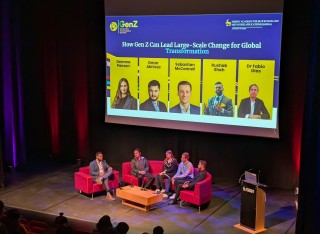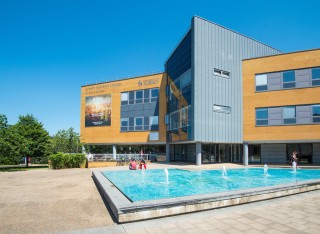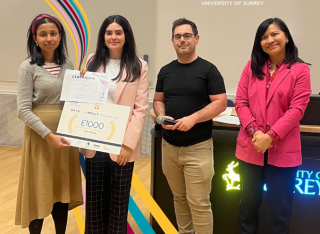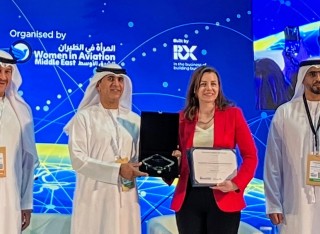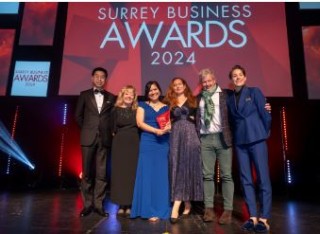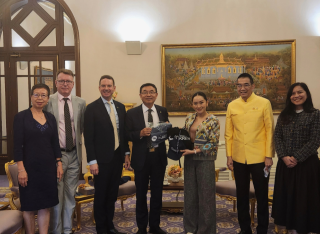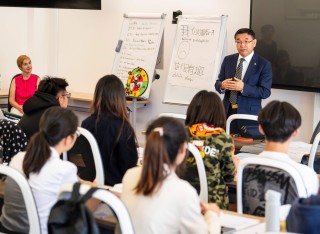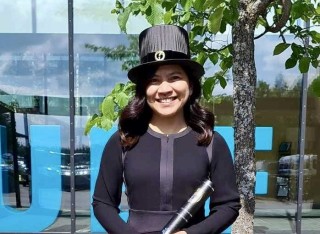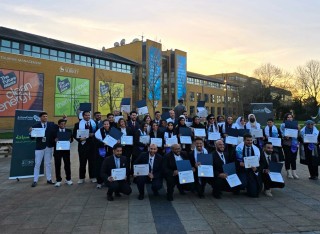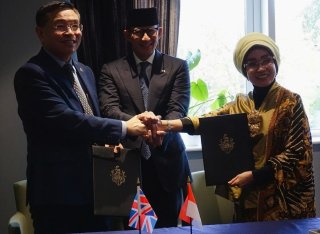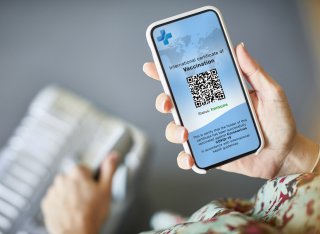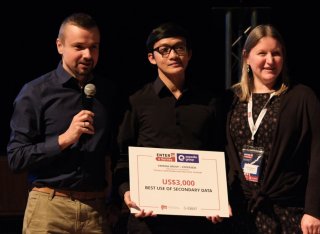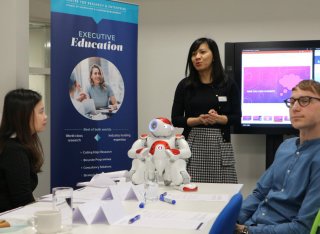
Professor Iis Tussyadiah
Academic and research departments
Surrey Business School, Surrey Hospitality and Tourism Management, Surrey Institute for People-Centred Artificial Intelligence (PAI).About
Biography
Iis Tussyadiah is Professor of Intelligent Systems in Service, Dean of Surrey Business School, and Fellow of the Surrey Institute for People-Centred Artificial Intelligence at University of Surrey. Iis is an advocate of utilising technology to forge new pathways to a better future. She is internationally recognised for her contributions to research on digital transformation in the services sector, particularly in travel and tourism. Her major work has influenced international and national policies on climate change mitigation, data privacy, the role of AI in the European Green Deal, global benchmarks for tourism development, and digital employment. Iis has received numerous awards, including Clarivate’s Highly Cited Researcher in 2021 and 2022 in the field of Social Sciences. In 2024, she was awarded Honorary Doctorate in Business Studies by University of Eastern Finland.
Iis is a strong proponent of the transformative approach to education, research, and partnerships to realise the academic missions of higher education institutions. As a first-generation university graduate, she has benefited directly from this transformation. This is reflected in the Surrey Business School's culture, Incubating Vibrant Futures 2024-2030, and previously the School of Hospitality and Tourism Management (SHTM)'s Global Leadership Strategy 2021-2024. Read her interview with Higher Education Digest on Leading with purpose in an AI future.
She has held leadership positions in various industry organisations, including President of the International Federation for Information Technologies and Travel & Tourism (IFITT) and founding member of the Alliance for Innovators and Researchers in Tourism and Hospitality (AIRTH). She also contributed to the 2021 and 2024 editions of the World Economic Forum's Travel & Tourism Development Index (TTDI) and the World Travel & Tourism Council's Women Empowerment Initiative.
Iis obtained her Ph.D. in Information Systems from Tohoku University, Japan, where she received the GSIS Dean's Award for Excellent Achievements in Doctoral Studies in 2007. She held academic positions at Temple University and Washington State University, USA.
Areas of specialism
University roles and responsibilities
- Dean of Surrey Business School
My qualifications
Previous roles
News
In the media
ResearchResearch interests
- Technology for behaviour change; experience design; behavioural intervention; digital nudging
- Artificial intelligence, robotics, and automation in services; human-AI teaming and future of work
- Sharing economy; collaborative consumption; peer-to-peer accommodation
- Immersive experiences; virtual reality, augmented reality, gamification
- Human-computer interaction; technology-mediated experiences
:: Find me on Google Scholar and Sage Policy Profiles ::
Research projects
The PriVELT Project (2018 - 2022) involves a group of researchers working in five academic disciplines (Computer Science, Tourism and Hospitality Management, Psychology, Business, Law) at four UK universities (University of Kent, University of Surrey, University of Warwick, and Durham University). The project is led by Prof Shujun Li of Kent Interdisciplinary Research Centre in Cyber Security (KirCCS), University of Kent. It has an overall budget of £1.4m, with 80% (£1.13m) funding from Engineering and Physical Sciences Research Council (EPSRC). It is part of 11 granted projects following EPSRC's 2017 call on "Trust, Identity, Privacy and Security in the Digital Economy 2.0 (TIPS2)". PriVELT addresses the two-sided challenges associated with offering a seamless and highly personalised end-to-end travel experience while balancing the privacy and security needs of leisure travellers. PriVELT aims to develop an innovative user-centric and privacy-aware digital platform that will empower leisure travellers to better manage the sharing of their personal data with travel service providers and other entities and foster new business opportunities for the travel and tourism industry through encouraging better (more transparent and effective) usage of travellers' data.
Surrey's researchers (Grant: EP/R033196/1): Prof Iis Tussyadiah (PI), Prof Graham Miller (CI), Prof Annabelle Gawer (CI), and Dr Athina Ioannou (RF).
Research collaborations
Visiting Scholars:
- Jiarui Chang, The Hong Kong Polytechnic University (2025)
- Dr Kadir Çakar, Mardin Artuklu University, Turkiye (2024-2025)
- Prof Si Shi, Southwestern University of Finance and Economics, China (2024-2025)
- Halim Budi Santoso, National Tsing Hua University, Taiwan (2023)
- Dr Henry Tsai, The Hong Kong Polytechnic University (2023)
- Dr Dan Wang, The Hong Kong Polytechnic University (2023)
- Dr Chunhui Zheng, Guangzhou University, China (2023)
- Yingying Du, Nankai University, China (2022-2023)
- Dr Monica Segovia Perez, Rey Juan Carlos University, Spain (2022)
- Elena Cerdá-Mansilla, Autonomous University of Madrid, Spain (2021)
- Dr Yuya Ieiri, Waseda University, Japan (2021)
- Dr Alia Rahman, University Malaysia Terengganu, Malaysia (2019-2020)
- Beatriz Benitez-Aurioles, Málaga University, Spain (2019)
- Dr Myunghwa (Michelle) Kang, University of Nebraska-Lincoln, USA (2019)
- Sergio Ibáñez Sánchez, University of Zaragoza, Spain (2019)
- Francisco (Paco) Femenia-Serra, University of Alicante, Spain (2019)
- Dr María del Rosario (Rosa) González-Rodríguez, University of Seville, Spain (2018)
- Prof Chulmo Koo, Kyung Hee University, South Korea (2018)
- Prof Namho Chung, Kyung Hee University, South Korea (2017)
Past research projects and collaborations
- Tussyadiah, I. (PI), Femenia-Serra, F., Setty, E., Leveringhaus, A. "The Ethics of AI Influencers," sponsored by Faculty of Arts and Social Sciences Challenge Fund + UKRI Strategic Priorities Fund 2019. [Internal]
- Wang, D., Fesenmaier, D., Tussyadiah, I. "Conceptualising in-destination decision making by tourists," sponsored by Hong Kong Research Grant Council (RGC) General Research Fund (GRF) 2018/2019.
- Tussyadiah, I. (PI), Miller, G. "Intelligent solutions for proenvironmental behaviour change," sponsored by Faculty of Arts and Social Sciences, University of Surrey, FASS Pump Priming Fund 2018. [Internal]
- Howarth, C. (PI), Jones, C., Tussyadiah, I., Kantenbacher, J., Tian, S. "Increasing sustainable travel behaviour in urban environments: Proactive and reactive responses to environmental images in a digital setting," sponsored by University of Surrey, Urban Living Award 2018. [Internal]
- Stangl, B. (PI), Tussyadiah, I. "Assessing the effectiveness of game design elements for interpretative experiences in tourist places," sponsored by Faculty of Arts and Social Sciences, University of Surrey, FASS Pump Priming Fund 2018. [Internal]
- Tussyadiah, I.P. “Online Self-Presentation Strategies in the Sharing Economy,” sponsored by Carson College of Business, Washington State University (Summer Research Grant), May 16, 2016 – September 30, 2016. [Internal]
- Wallace, S. (PI), Zach, F., Tussyadiah, I.P. “Twitter Sentiment Analysis,” sponsored by Washington State University Vancouver (Research Mini Grant), May 16, 2016 – May 15, 2017. [Internal]
- Zach, F. (PI), Tussyadiah, I.P. “Virtual Reality and its Effects on Sales,” sponsored by Carson College of Business, Washington State University (Industry Research Fund), March 16, 2016 – August 15, 2017. [Internal]
- Wang, D. (PI), Tussyadiah, I.P. “The Narrative Persuasion of Virtual Reality Imagery for Tourism Marketing,” sponsored by the School of Hotel & Tourism Management, the Hong Kong Polytechnic University, Hong Kong SAR, China, January 1, 2016 – December 31, 2017.
- Tussyadiah, I.P. (PI), Zach, F., Wallace, S., Munkhjargal, S., "Twitter-feed Analysis of Travel and Tourism in Pierce County, Washington," Sponsored by Pierce County, Washington, September 15, 2015 – December 31, 2016.
- Goucher, C. (PI), Narayanan, P., Zach, F., Tussyadiah, I.P., Doutrich, D., “Local Food Justice through Global Citizenship: Civic Lessons from the Rural Caribbean,” Sponsored by Washington State University Vancouver (Diversity Research Grant), 2015 - 2016. [Internal]
- Tussyadiah, I.P., "Text Analytics of Peer-to-Peer Accommodation Reviews," Sponsored by the Carson College of Business (Summer Research Grant), Washington State University Vancouver, May 16, 2015 – August 14, 2015. [Internal]
- Tussyadiah, I.P., "Assessing Consumer Intention to Participate in Co-Creation of New Tourism Services," Sponsored by the Carson College of Business (Summer Research Grant), Washington State University Vancouver, May 16, 2014 – August 14, 2014. [Internal]
- Wang, D. (PI), Tussyadiah, I.P., "The Spillover Effects of Daily Use of Mobile Technology to the Travel Domain: Cognitive and Embodied Approaches," Sponsored by Hong Kong Polytechnic University, Hong Kong SAR, China, July 1, 2013 – December 1, 2014.
- Tussyadiah, I.P., "Quilt Gardens Tour Experience Study 2010," Sponsored by Elkhart County Conventions & Visitors Bureau, Indiana, May 1, 2010 - April 30, 2011.
- Zach, F. (PI), Tussyadiah, I.P., "The City of Cape May Tourism Plan - Extension," Sponsored by The City of Cape May, New Jersey, 2011 - 2012.
- Roehl, W. S. (PI), Zach, F., Tussyadiah, I.P., Fesenmaier, D. R., Barber, E. H., "The City of Cape May Tourism Plan," Sponsored by The City of Cape May, New Jersey, September 1, 2009 - March 31, 2011.
- Tussyadiah, I.P. (PI), Zach, F., "Quilt Gardens Tour Experience Study 2009," Sponsored by Elkhart County Conventions & Visitors Bureau, Indiana, May 1, 2009 - April 30, 2010.
- Fesenmaier, J. (PI), Tussyadiah, I.P., "Evaluation of Visitor Experience," Sponsored by The Franklin Institute, Philadelphia, June 2008 - December 2008.
- Yoo, Y. (PI), Tussyadiah, I.P., Saari, T., Fesenmaier, D.R., "Mobile Computing and User-Activated Narrative Networks in Tourism," Sponsored by Samsung Electronics, Inc., February 1, 2007 - September 30, 2008.
Research interests
- Technology for behaviour change; experience design; behavioural intervention; digital nudging
- Artificial intelligence, robotics, and automation in services; human-AI teaming and future of work
- Sharing economy; collaborative consumption; peer-to-peer accommodation
- Immersive experiences; virtual reality, augmented reality, gamification
- Human-computer interaction; technology-mediated experiences
:: Find me on Google Scholar and Sage Policy Profiles ::
Research projects
The PriVELT Project (2018 - 2022) involves a group of researchers working in five academic disciplines (Computer Science, Tourism and Hospitality Management, Psychology, Business, Law) at four UK universities (University of Kent, University of Surrey, University of Warwick, and Durham University). The project is led by Prof Shujun Li of Kent Interdisciplinary Research Centre in Cyber Security (KirCCS), University of Kent. It has an overall budget of £1.4m, with 80% (£1.13m) funding from Engineering and Physical Sciences Research Council (EPSRC). It is part of 11 granted projects following EPSRC's 2017 call on "Trust, Identity, Privacy and Security in the Digital Economy 2.0 (TIPS2)". PriVELT addresses the two-sided challenges associated with offering a seamless and highly personalised end-to-end travel experience while balancing the privacy and security needs of leisure travellers. PriVELT aims to develop an innovative user-centric and privacy-aware digital platform that will empower leisure travellers to better manage the sharing of their personal data with travel service providers and other entities and foster new business opportunities for the travel and tourism industry through encouraging better (more transparent and effective) usage of travellers' data.
Surrey's researchers (Grant: EP/R033196/1): Prof Iis Tussyadiah (PI), Prof Graham Miller (CI), Prof Annabelle Gawer (CI), and Dr Athina Ioannou (RF).
Research collaborations
Visiting Scholars:
- Jiarui Chang, The Hong Kong Polytechnic University (2025)
- Dr Kadir Çakar, Mardin Artuklu University, Turkiye (2024-2025)
- Prof Si Shi, Southwestern University of Finance and Economics, China (2024-2025)
- Halim Budi Santoso, National Tsing Hua University, Taiwan (2023)
- Dr Henry Tsai, The Hong Kong Polytechnic University (2023)
- Dr Dan Wang, The Hong Kong Polytechnic University (2023)
- Dr Chunhui Zheng, Guangzhou University, China (2023)
- Yingying Du, Nankai University, China (2022-2023)
- Dr Monica Segovia Perez, Rey Juan Carlos University, Spain (2022)
- Elena Cerdá-Mansilla, Autonomous University of Madrid, Spain (2021)
- Dr Yuya Ieiri, Waseda University, Japan (2021)
- Dr Alia Rahman, University Malaysia Terengganu, Malaysia (2019-2020)
- Beatriz Benitez-Aurioles, Málaga University, Spain (2019)
- Dr Myunghwa (Michelle) Kang, University of Nebraska-Lincoln, USA (2019)
- Sergio Ibáñez Sánchez, University of Zaragoza, Spain (2019)
- Francisco (Paco) Femenia-Serra, University of Alicante, Spain (2019)
- Dr María del Rosario (Rosa) González-Rodríguez, University of Seville, Spain (2018)
- Prof Chulmo Koo, Kyung Hee University, South Korea (2018)
- Prof Namho Chung, Kyung Hee University, South Korea (2017)
Past research projects and collaborations
- Tussyadiah, I. (PI), Femenia-Serra, F., Setty, E., Leveringhaus, A. "The Ethics of AI Influencers," sponsored by Faculty of Arts and Social Sciences Challenge Fund + UKRI Strategic Priorities Fund 2019. [Internal]
- Wang, D., Fesenmaier, D., Tussyadiah, I. "Conceptualising in-destination decision making by tourists," sponsored by Hong Kong Research Grant Council (RGC) General Research Fund (GRF) 2018/2019.
- Tussyadiah, I. (PI), Miller, G. "Intelligent solutions for proenvironmental behaviour change," sponsored by Faculty of Arts and Social Sciences, University of Surrey, FASS Pump Priming Fund 2018. [Internal]
- Howarth, C. (PI), Jones, C., Tussyadiah, I., Kantenbacher, J., Tian, S. "Increasing sustainable travel behaviour in urban environments: Proactive and reactive responses to environmental images in a digital setting," sponsored by University of Surrey, Urban Living Award 2018. [Internal]
- Stangl, B. (PI), Tussyadiah, I. "Assessing the effectiveness of game design elements for interpretative experiences in tourist places," sponsored by Faculty of Arts and Social Sciences, University of Surrey, FASS Pump Priming Fund 2018. [Internal]
- Tussyadiah, I.P. “Online Self-Presentation Strategies in the Sharing Economy,” sponsored by Carson College of Business, Washington State University (Summer Research Grant), May 16, 2016 – September 30, 2016. [Internal]
- Wallace, S. (PI), Zach, F., Tussyadiah, I.P. “Twitter Sentiment Analysis,” sponsored by Washington State University Vancouver (Research Mini Grant), May 16, 2016 – May 15, 2017. [Internal]
- Zach, F. (PI), Tussyadiah, I.P. “Virtual Reality and its Effects on Sales,” sponsored by Carson College of Business, Washington State University (Industry Research Fund), March 16, 2016 – August 15, 2017. [Internal]
- Wang, D. (PI), Tussyadiah, I.P. “The Narrative Persuasion of Virtual Reality Imagery for Tourism Marketing,” sponsored by the School of Hotel & Tourism Management, the Hong Kong Polytechnic University, Hong Kong SAR, China, January 1, 2016 – December 31, 2017.
- Tussyadiah, I.P. (PI), Zach, F., Wallace, S., Munkhjargal, S., "Twitter-feed Analysis of Travel and Tourism in Pierce County, Washington," Sponsored by Pierce County, Washington, September 15, 2015 – December 31, 2016.
- Goucher, C. (PI), Narayanan, P., Zach, F., Tussyadiah, I.P., Doutrich, D., “Local Food Justice through Global Citizenship: Civic Lessons from the Rural Caribbean,” Sponsored by Washington State University Vancouver (Diversity Research Grant), 2015 - 2016. [Internal]
- Tussyadiah, I.P., "Text Analytics of Peer-to-Peer Accommodation Reviews," Sponsored by the Carson College of Business (Summer Research Grant), Washington State University Vancouver, May 16, 2015 – August 14, 2015. [Internal]
- Tussyadiah, I.P., "Assessing Consumer Intention to Participate in Co-Creation of New Tourism Services," Sponsored by the Carson College of Business (Summer Research Grant), Washington State University Vancouver, May 16, 2014 – August 14, 2014. [Internal]
- Wang, D. (PI), Tussyadiah, I.P., "The Spillover Effects of Daily Use of Mobile Technology to the Travel Domain: Cognitive and Embodied Approaches," Sponsored by Hong Kong Polytechnic University, Hong Kong SAR, China, July 1, 2013 – December 1, 2014.
- Tussyadiah, I.P., "Quilt Gardens Tour Experience Study 2010," Sponsored by Elkhart County Conventions & Visitors Bureau, Indiana, May 1, 2010 - April 30, 2011.
- Zach, F. (PI), Tussyadiah, I.P., "The City of Cape May Tourism Plan - Extension," Sponsored by The City of Cape May, New Jersey, 2011 - 2012.
- Roehl, W. S. (PI), Zach, F., Tussyadiah, I.P., Fesenmaier, D. R., Barber, E. H., "The City of Cape May Tourism Plan," Sponsored by The City of Cape May, New Jersey, September 1, 2009 - March 31, 2011.
- Tussyadiah, I.P. (PI), Zach, F., "Quilt Gardens Tour Experience Study 2009," Sponsored by Elkhart County Conventions & Visitors Bureau, Indiana, May 1, 2009 - April 30, 2010.
- Fesenmaier, J. (PI), Tussyadiah, I.P., "Evaluation of Visitor Experience," Sponsored by The Franklin Institute, Philadelphia, June 2008 - December 2008.
- Yoo, Y. (PI), Tussyadiah, I.P., Saari, T., Fesenmaier, D.R., "Mobile Computing and User-Activated Narrative Networks in Tourism," Sponsored by Samsung Electronics, Inc., February 1, 2007 - September 30, 2008.
Supervision
Postgraduate research supervision
- Jiaolong (Mia) Cheng (Co-Supervisor). Topic: Technology-induced alienation in smart hotels. Primary supervisor: Dr Daisy Liu
- Haoyue (Elsa) Yu (Co-Supervisor). Topic: Human-AI teaming in tourism marketing. Primary Supervisor: Dr Erin Ling; Co-supervisor: Prof Adrian Hilton
- Septi Fahmi Choirisa (Principal Supervisor). Topic: GenAI and strategic foresight capacity for business resilience. Co-supervisor: Dr Erin Ling
- Yoonjung (Julie) Kim (Principal Supervisor). Topic: GenAI and decision-making for ADHD tourists. Co-supervisor: Dr Bora Kim
- Mengxi Chen (Surrey Principal Supervisor). Dual PhD with HKPU. Co-Supervisor: Dr Bora Kim.
Completed postgraduate research projects I have supervised
Supervision
- Brana Jianu, PhD (2025). University of Surrey, UK (Principal Supervisor). First position post-PhD: University of Surrey and Study Group, UK
- Gilang Maulana Majid, PhD (2024). University of Surrey, UK (Principal Supervisor). First position post-PhD: private sector, Indonesia
- Ikram Nur Muharam, PhD (2023). University of Surrey, UK (Principal Supervisor). First position post-PhD: Bank Syariah Indonesia (BSI Institute) and Universitas Padjadjaran, Indonesia
- Erin Chao Ling, PhD (2021). University of Surrey, UK (Principal Supervisor). First position post-PhD: University of Huddersfield, UK
- Lauren Siegel, PhD (2021). University of Surrey, UK (Principal Supervisor). First position post-PhD: University of Greenwich, UK
- Birgit Altrichter, PhD (2021). University of Surrey, UK (Co-Supervisor). First position post-PhD: University of Surrey, UK
- Aarni Tuomi, PhD (2021). University of Surrey, UK (Principal Supervisor). First position post-PhD: Haaga-Helia University of Applied Sciences, Finland
- Yujia (Penny) Chen, PhD (2020). University of Surrey, UK (Principal Supervisor). First position post-PhD: Nankai University, China
- Hyerhim Kim, PhD (2020). University of Surrey, UK (Principal Supervisor). First position post-PhD: University of Essex, UK
- Geunhee Lee, PhD (2012). Temple University, USA. First position post-PhD: Ritsumeikan Asia Pacific University, Japan
- Dan Wang, PhD (2012). Temple University, USA. First position post-PhD: the Hong Kong Polytechnic University, Hong Kong SAR
- Sangwon Park, PhD (2012). Temple University, USA. First position post-PhD: University of Surrey, UK
Examination/Viva Voce
- Li Xie-Carson (2023). The University of Queensland, Australia (External)
- Abdulaziz Choudhry (2021). RMIT University, Australia (External)
- Lino Trinchini (2020). Manchester Metropolitan University, UK (External)
- Nuttanuch Issariyakulkarn (Tharn), PhD (2020). University of Surrey, UK (Internal)
- Cristina Michelini, PhD (2019). The Hong Kong Polytechnic University, Hong Kong (External)
- Alia Rahman, PhD (2016). Flinders University, Australia (External)
- Anja Dinhopl, PhD (2015). The University of Queensland, Australia (External)
- Lidija Lalicic, PhD (2015). MODUL University Vienna, Austria (External)
Teaching
- Business Research Methods (UG)
- Current Issues in Hotel Development and Management (PG)
- Designing Digital Hospitality Services (PG)
- Digital Marketing and Social Media in Tourism (PG)
- Research Methods (PG)
- Smart Tourism and Event Design (PG)
- Technology, Change, and Innovation (PG)
- Tourism Social Science (PG)
- Applied Research in Tourism, Hospitality, and Events (UG)
- Technology, Media, and Data (UG)
- Digital Transformation in Hospitality (Exec Ed)
- Change Management in Hospitality (Exec Ed)
- Tourism Experience Design (MBA/External)
Sustainable development goals
My research interests are related to the following:
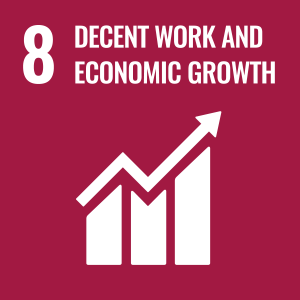

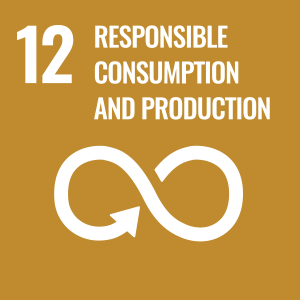
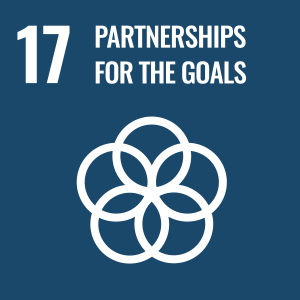
Publications
Purpose - As algorithmic management expands within traditional hospitality workplaces, understanding its impact on employees becomes essential. This study investigates how employees’ perceptions of algorithmic management influence their resistance to these systems, well-being, and turnover intentions.Design/methodology/approach - A mixed-methods approach, combining qualitative interviews (Study 1), quantitative surveys to validate and test the model (Study 2) and a between-subjects online experiment (Study 3), was employed to explore these dynamics under varying conditions of algorithmic control, managerial involvement, and algorithmic opacity.Findings - The results indicate that while algorithmic enhancements positively influence well-being, they do not diminish resistance to algorithmic management, which is primarily driven by algorithmic restraints. Resistance negatively impacts well-being, which in turn drives turnover intentions. Furthermore, a non-linear relationship between enhancements and restraints emerges, indicating an optimal point at which enhancements are maximised. Human managers play a critical moderating role by providing emotional support and facilitating transparency in algorithmic decision-making.Originality – This study identifies resistance as a mediator of employee well-being, and the results indicate that technology acceptance and resistance can co-exist. It provides an employee-centred perspective on attitudes towards technology in hospitality, thus offering a novel view compared to prevailing consumer-focused technology acceptance models.
This study proposes that the humanisation of algorithmic management systems can emerge through the organisational sociomaterial dynamics, co-created through practice. Drawing on 30 semi-structured interviews with hospitality and algorithmic management stakeholders, and public documents analysis, we propose a framework of algorithmic management in hospitality workplaces as a sociomaterial accomplishment. We show that managerial and employee practices are performatively co-constituted with algorithmic affordances through ongoing sociomaterial enactments, configured by strategic modalities of (in)visibility. These visibility regimes actively structure conditions of power, influencing the extent to which algorithmic management is enacted as (de)humanising.
This study aims to (1) investigate the transfer of experiential value between virtual and physical tourism contexts, (2) identify the internal and external factors influencing this transfer, and (3) develop an integrated theoretical framework to capture the dynamics of phygital tourism experiences. A systematic review of 116 peer-reviewed articles and a subsequent meta-analysis of 88 empirical studies (total sample: n = 28,545) identified key internal and external factors shaping user experiences through interactions across virtual and physical tourism spaces. Drawing on these findings, we propose the phygital tourism experience triad (PTET) framework, which conceptualizes experience formation as the alignment of cognitive and embodied actions, technological affordances, and spatial configurations spanning virtual spaces, physical tourism sites, and users' self-location (e.g., home). This research contributes valuable insights to guide future studies and informs the design and management of phygital tourism experiences.
The spatial practices of tourists have been reshaped by the rise of smartphones and social media, prompting new geographies of tourism that respond to the visual imperatives of the digital era. This paper explores the emergence of 'selfie parks' as purpose-built, enclavic spaces designed to accommodate social media-induced tourists. Positioned at the intersection of visual culture and spatial production, selfie parks represent a novel form of place-making driven by the aesthetics and performativity of Instagrammability. Drawing on empirical fieldwork in Bali, this study examines how these photographic enclaves reconfigure tourism space by concentrating visual consumption into managed, commodified zones. Contrary to earlier critiques of tourist enclaves, which highlight issues such as socio-spatial segregation and high economic leakages, this research demonstrates how selfie parks can enable local communities to effectively manage the economic opportunity that social media-induced visitors may offer, as well as providing a safe and convenient atmosphere. Furthermore, it considers how spatial interventions such as controlled entry schemes can help mitigate the pressures of overtourism in destinations experiencing high demand from social media-induced tourists. This study is the first to consider selfie parks as tourism enclaves, while contributing to literature on visual production and management of tourists.
Graduates play a critical role in countering negative stigma and safeguarding the reputation of tourism education, yet their attitudes remain underexplored. This study investigates how intrinsic competences (e.g. transferable skills, personal interest) and extrinsic stressors (e.g. employment stress, occupational stigma) shape graduates’ attitudes toward tourism degrees. These findings indicate that innovative ability, empathy, and service awareness positively contribute to perceived career benefits. Furthermore, both career benefits and personal interest significantly enhance graduates’ cognitive and affective attitudes. While employment stress negatively affects affective attitudes, occupational stigma unexpectedly has a positive effect through activating a cultural and psychological mechanism. These results provide valuable theoretical and practical implications for advancing tourism education, highlighting the need to leverage graduates’ potential as ambassadors for the field.
This study examines how flashback nudging-a reminder of past pro-environmental actions-delivered through a chatbot survey over 6 weeks in a quasi-experimental design, can facilitate pro-environmental behavior spillover among tourists visiting nature-based destinations. Integrating conversational artificial intelligence allows for personalized, timely, and scalable interventions, making the delivery of flashback nudges more efficient and engaging than traditional methods. Flashback nudging effectively strengthens the impact of environmental self-identity on behavioral change. Although nudges take time to work, the multigroup analysis revealed significant differences in self-reported past pro-environmental behaviors between the treatment and control groups. The findings demonstrate the importance of deliberate, technology-enabled interventions in enhancing meaning-making processes and promoting transformative tourism experiences. Artificial intelligence advances behavior change efforts by enabling innovative, lasting environmental engagement. This study emphasizes the potential of conversational artificial intelligence to drive tourism's contributions to a sustainable future, advancing the discourse on leveraging technology for behavioral interventions in tourism.
[This dataset contains all data used for Studies 2 (qualitative), 3 (quantitative survey) and 4 (longitudinal) in my PhD research.]Thesis abstract:This thesis explores the potential positive impact of artificial intelligence (AI) technology on sustainability in and outside of the tourism industry through four studies. Study 1 introduced the AI4GoodTourism framework, emphasising the need for sustainability inclusion and tourist involvement to achieve a successful sustainability transition. Five themes were identified through a systematic review: intelligent automation to enhance tourist experience, preserve heritage, promote quality of life, measure tourist experience, and preserve the environment. The latter theme was the least explored scholarly topic. Study 2 conceptualised a conversational AI chatbot to promote pro-environmental behaviour spillover among tourists visiting the Gili Islands, Indonesia. A theoretical model was proposed, highlighting factors influencing chatbot usage and spillover effects. Study 3 identified relationships between factors from Study 2, revealing that factors such as performance expectancy, timing, and credibility significantly influenced people’s intention to use the proposed chatbot technology. A significant relationship was established between people’s intentions to use the chatbot and environmentally friendly transport. Scenario-based experiments showed that using the chatbot with educational information on sustainability was sufficient to trigger behaviour change. Study 4 explored the underlying mechanism of pro-environmental behaviour spillover through human-chatbot interactions using flashback nudging. A longitudinal experiment involving the Gili tourists demonstrated that flashback nudging delivered through chatbot technology strengthened their environmental self-identity, leading to significant differences in self-reported pro-environmental behaviour between treatment and control groups. In conclusion, the thesis demonstrates that AI technology, designed with high sustainability inclusion, can positively impact sustainability through tourists’ marginal contributions. The proposed AI4GoodTourism framework and the conceptualised chatbot technology, especially with flashback nudging, show potential for facilitating pro-environmental behaviour spillovers among tourists. All four studies in this thesis highlight the importance of prioritising sustainability in AI innovations for the tourism industry, offering insights for future AI development and adoption to support the global sustainability agenda.
In-destination travel decisions exist due to uncertainties after arrival and the flexibility of leisure travel. Concurrently, smartphone use encourages instant information searching and communication, which promotes in-destination decision-making and plan changes. However, previous studies have provided a limited understanding of in-destination decisions, particularly when travel companions are involved. This study thus adopted sociomateriality as a theoretical tool to offer a sociotechnical perspective in examining the interactions between travelers and their smartphones in an in-destination group decision-making context. We identified three communication patterns in group decision-making during trips and four features of smartphone sociomateriality: knowledgeability, thriftiness, referenceability, and negotiability. This study responds to recent calls to extend the theoretical repertoire of information technology and tourism research, and to conduct more empirical studies on tourists’ in-destination behaviors in the mobile Internet age.
The implementation of artificial intelligence, robotics, and automation in tourism and hospitality has received increasing attention from researchers and practitioners alike. It is expected that innovative technological solutions will bring a host of transformation to the sector (Ivanov & Webster, 2019). While examples of full automation in tourism remain scant, understanding the factors influencing organizational decision to adopt automation is important to assess the likelihood to increase adoption rate in the future. Of interest is identifying potentially modifiable factors that can be employed to improve adoption of best practices (Wisdom et al., 2014). Thus far, no empirical studies have been done to address this. This research aims to fill the gap by providing a set of factors identified by practitioners as driving the organizational adoption of automation. The results suggest avenues for further research and offer best practices to implement automation in tourism.
This systematic review is a trailblazer for the blockchain-based sharing economy concept, mainly for hospitality and tourism. It highlights the potential integration of blockchain across sharing economy sectors (e.g., accommodation, transportation, and business services). Following the PRISMA protocol, 43 publications from 12 scholarly databases were analysed. It identifies different types of implementations, including decentralised apps and specific functionalities that utilise blockchain. Key issues are discussed, including contradictory aspects (transparency vs privacy, centralisation within decentralisation, and users' euphoria vs technical barriers) and advantages (increased security, automated sharing mechanisms, and user participation). The review offers practical implementation paths for blockchain-based sharing economy systems in hospitality and tourism, emphasising the importance of context, scope limitation, focusing on increasing advantages, and managing technological trade-offs. It also suggests critical future research topics and action agendas for hospitality and tourism stakeholders. •Knowledge synthesises of hospitality and tourism blockchain-based sharing economy.•A comprehensive review of 43 scholarly blockchain-based sharing economy articles.•Issues and use cases of hospitality and tourism blockchain-based sharing economy.•Benefits and challenges of blockchain in hospitality and tourism sharing economy.•Implementation framework of the blockchain-based sharing economy is proposed.
The digitalization of society is crucial in achieving economic competitiveness and societal well-being. The pandemic has accelerated the digitalization of the tourism and hospitality sectors, which has fostered the emergence of more competitive, innovative, responsible, inclusive and sustainable business models. As the tourist experience is at the core of tourism management and constitutes the essence of tourism and hospitality (Tussyadaiah, 2014), most business models are oriented toward the tourist experience. Among the technologies known as Industry 4.0, immersive technologies are crucial for digitizing the hospitality and tourism industry due to the intangible and experiential nature of the tourist experience (Tussyadiah et al., 2018). Immersive technologies transform how people experience real and virtual environments (Hoyer et al., 2020). Milgram and Kishino (1994) introduced the reality-virtuality continuum to categorize different realities. Flavián et al. (2019) further developed the continuum by introducing the concept of pure mixed reality, in which virtual objects perfectly integrate with the physical world. This advancement reflects the technological progress that supports digital-physical interactions. In the commercial context, virtual reality (VR), augmented reality (AR), augmented virtuality (AV) and pure mixed reality (PMR) are creating new environments where real and digital elements are combined at different levels. This integration results in hybrid customer experiences.
Sitting at the intersection between social and computer sciences, human-computer interaction research focuses on understanding human behavior in relation to computer systems (Olson & Olson, 2002). Having seen many developments over the years, human-computer interaction has been a focal point in sector-specific research, including in tourism management (Stankov & Gretzel, 2020; Tung & Law, 2020). Recently, attention has been given to human-artificial intelligence interaction in particular. For instance, Lu et al.'s (2019) Service Robot Integration Willingness Scale and Gursoy et al.'s (2019) Artificially Intelligent (AI) Device Use Acceptance model explore guests' willingness to accept different types of AI in tourism contexts, while Fu et al. (2022) have put forward the Robot Usage Resistance model to explain tourism employees' reasons for resisting the use of robots. Most recently, user interfaces based on large language models have rapidly grown in popularity (Shanahan et al., 2023). Language model based consumer products, such as ChatGPT or Gemini, offer tourism companies new ways of working (Tuomi, 2023). For instance, Expedia recently launched language model based trip-planning tools (Biesiada, 2023), InterContinental Hotels Group is building a similar tool to improve booking experience (IHG, 2024), while Air Canada made headlines when their language model offered tourists discounts that did not exist (Garcia, 2024). Importantly, the potential for so called ‘generative artificial intelligence’ goes beyond major tourism corporations or tourist-artificial intelligence interaction. New tools facilitate the construction and sharing of Custom Assistants – customized versions of popular large language models – at a click of a few buttons, providing new affordances for tourism businesses and other stakeholders by facilitating new types of human-computer interaction in tourism, including tourist-artificial intelligence, employee-artificial intelligence, business-artificial intelligence and policymaker-artificial intelligence.
Given proper facilitation, pro-environmental behaviour in tourist destinations may spill over to the daily lives of tourists. Recent advancements in conversational artificial intelligence (AI) may lead to the emergence of more effective technology that will encourage people to become more environmentally friendly. However, limited research has been devoted to understanding the complexity of using such technologies for pro-social nudging. This study applies rigorous scale development procedures to test how advanced conversational AI, like chatbots, can be effective in encouraging pro-environmental behaviour spillover. The conceptual model introduces seven factors that predict people's intention to use the chatbot and three factors that predict their intention to embrace the target behaviour. Performance expectancy and timing were the most significant in predicting the intention of individuals to adopt the technology. Efficiency and government support were the chief drivers of the intention to adopt the pro-environmental behaviour. The findings suggest that although introducing a technology-mediated nudging mechanism can trigger people's intention to behave pro-environmentally, other factors must be fulfilled in order to ensure sustained behaviour change in society.
Recent advancement in Generative Conversational Artificial Intelligence (AI) has opened the possibility of promoting chatbots for nudging. Tourists returning home from destinations that enforce sustainable transport regulations might be nudged to continue traveling sustainably. Through exploratory qualitative research, this study conceptualizes a chatbot to facilitate pro-environmental behavior spillover among domestic tourists in the Gili Islands, Indonesia. The Service Design approach and Grounded Theory were applied throughout the data collection process involving semi-structured in-depth interviews, focus group discussions and field observations. Insights obtained from stakeholders from multidisciplinary backgrounds were used to provide an overview of how the chatbot can be developed and the potential impact it could bring. A theoretical model predicting factors that play important roles in adopting the proposed chatbot and its respective nudges was developed. It informs policymakers and practitioners about the potential use of AI to help transform tourist experiences and shape lasting responsible behaviors.
This study employs a sequential exploratory mixed-methods approach to investigate users' perspectives and acceptability of blockchain-based sharing economy systems. The suggested model explains how users' perceptions of specific features of such concepts influence acceptance in ways that existing theories like TPB, TAM, or UTAUT cannot. The results revealed that user empowerment was the most significant factor influencing acceptance. Furthermore, multigroup analysis (MGA) demonstrates how different contexts have distinct acceptance predictors. Depending on the context, perceived lower fees, perceived faster settlement, perceived income distribution, perceived fraudproof, and perceived traceability had varying significance. Meanwhile, perceived immutability, perceived process automation, and perceived transparency, even though considered appealing, were not significant in influencing acceptance. The findings imply that stakeholders should balance technicality and behavioural aspects, and be aware of the context.
Blockchain could disrupt traditional accommodation services by enabling safe, decentralised direct connections between guests and hosts. However, how users will accept and use blockchain-based services in tourism and hospitality remains unascertained. This study explores users’ perceptions of a blockchain-based peer-to-peer accommodation system and sets a theoretical basis to conceptualise the drivers of the acceptability of such system. By using a grounded theory approach involving theoretical sampling and three steps of coding and constant comparison procedures, this study revealed that users were drawn to the system because it delivers desirable characteristics that are absent from existing services, such as further reduction of transaction fees, instant transaction settlement, wider income distribution, data integrity, algorithm autonomy, and smart protocol. Personal and social contexts were also found to influence users’ preferences for blockchain type and system ownership models. By offering key predictors and a theoretical model of user acceptance of a blockchain-based peer-to-peer accommodation system, hence taking a bottom-up approach to complement the highly top-down extant literature, this paper allows stakeholders exploring the use of blockchain technology in the tourism and hospitality sectors to have a comprehensive understanding of the phenomenon.
The growing interest in intelligent automation adoption and development in tourism presents many potential solutions for sustainable tourism issues. To map the current landscape of research on intelligent automation in sustainable tourism, a systematic review was conducted of 213 scholarly articles. Five major themes were identified: intelligent automation to enhance tourist experience, preserve heritage, promote quality of life, measure tourist experience, and conserve the environment. Scholarly work on this topic has paid more attention to the economic and sociocultural aspects of sustainability but less to addressing environmental issues. To uncover further research gaps, this study outlines sustainability transition pathways using two dimensions: sustainability inclusion and tourist involvement. Twenty-three distinct AI-based innovations were mapped onto the pathways to reveal future research directions. The findings explain the lack of AI-based solutions that offer high levels of sustainability inclusion and tourist involvement. Thus, this study proposes the 'AI4GoodTourism' framework, inferring that intelligent automation with high sustainability inclusion levels can scale up the marginal contributions that tourists provide collectively. This framework serves to guide future research and development for various stakeholders who are progressing sustainable tourism agendas through intelligent automation.
This study investigates how exposure to local prices changes the transaction utility of international tourists, and the role of purchasing power parity (PPP) and the use of cryptocurrency in these changes. Findings indicate that tourists’ transaction utility did not vary all that much when they visited a country with comparable PPP to their own. Meanwhile, when traveling to countries with a lower PPP, tourists enjoy a heightened transaction utility. Furthermore, using Bitcoin results in greater transaction utility than using fiat currency.
A two-stage study using text-mining and critical incident techniques was conducted to identify the service failure type in peer-to-peer accommodation and recovery strategies adopted to address them. Guests experience new types of service failure in peer-to-peer accommodation compared with traditional accommodations and online travel websites. Four service failure clusters have emerged from negative reviews sourced online: guest-host interaction, customer service, room and amenity, and payment. In-depth interviews further identified three dimensions of service failure, tangible, informational, and relational, with some incidents representing combinations of these dimensions. Service recovery strategies discussed in this study (compensation, substitution, apology, and no actions) are relatively similar to those adopted by hotels. Theoretical and practical implications are also provided.
This research proposes a framework of intergenerational learning (IGL) that supports child-to-parent influence in the context of heritage learning using augmented reality (AR) and serious game applications. Positioning children as the behavioural catalysts in the learning process, the framework is developed based on several considerations and requirements. First, the technologies are designed to play a role in attracting and engaging children in learning and providing an intergenerational participation structure to allow children to influence parents’ attitudes and behaviour. Second, using the mechanics, dynamics, and aesthetics framework of game design, the game elements are designed to provide realistic context for experiential learning, informative guiding and player interactions to increase engagement, as well as clear and measurable success indicators to increase motivation. The outcome of this framework is attitude and behaviour change in children and parents with regards to heritage preservation and appreciation, which is one of the main goals of heritage tourism managers.
A stimulus-response model of location-based social network marketing is conceptualized based on an exploratory investigation. Location-based social network applications are capable of generating marketing stimuli from merchant, competition-based, and connection-based rewards resulted from relevance and connectivity. Depending on consumption situations, consumer characteristics, and social network structure, these rewards lead to actual behavior that manifests in variety behavior (i.e., patronage to new places) and loyalty behavior (i.e., increased frequency of patronage to familiar places). This behavior implies changes in patterns of mobility, making this marketing approach particularly relevant for tourism and hospitality businesses. Managerial implications and recommendations for further studies are provided.
Drawing on the concept of mediation and scripting, this chapter applies a content-extraction method in an attempt to identify similarities and differences between images used by destination marketers and those shared by tourists at the visit and post-visit stages, and, most importantly, to identify the values created by the shared images for audiences in tourism settings. The official image data were selected from photo galleries of the Greater Philadelphia Tourism Marketing Corporation (GPTMC) website (gophila.com), resulting in 412 samples. Similarities of images provided on the GoPhila photo galleries within and between categories prove that destination marketing organizations have typically used similar types of images to communicate notions of the tourist experience to reinforce the desired image in the minds of potential travellers. On the other hand, based on the high similarities in regional, local and global semantics, it is also evident that some tourists tend to reproduce the same types of images projected to them at the pre-visit stage, resulting in continuous reproduction of destination representation.
Organised by the International Federation for Information Technology and Travel & Tourism (IFITT), the ENTER2018 PhD Workshop is a pre-conference event to provide a forum for doctoral students undertaking research related to Information and Communication Technology in Travel and Tourism to interactively discuss their research with peers, colleagues, and leading scholars in the field. This volume consists of 19 research proposals, including two recipients of the 2018 IFITT ICT4D Scholarship, awarded to young talents who work on the applications of ICT for development through tourism.
This paper presents a preliminary result of a study on the roles of inference making in decision heuristics involving P2P accommodation booking. The goals of the study are to identify the influence of cues from similar listings on a decision to book a target listing when reviews are not available (i.e., missing information) as well as the effects of decision-making styles on actual choice and decision confidence. Preliminary results showed that the inclusion of a similar listing (comparison) did not make a significant difference in decision confidence, which may indicate insignificant roles of external cues in booking decisions. Due to a limited number of participants in the pilot study, the main study with a larger number of participants may explicate the phenomenon more significantly. Should the results hold, they suggest P2P accommodation hosts pay more attention to the listing characteristics instead of relying on information from similar listings.
Smartphone technology has changed the scope of onsite travel behaviors and photographing practices. This paper explores the destination response of the Tourist Board of Vienna with their “anti-hashtag” marketing campaign, aimed at encouraging visitors to go offline while traveling in the city. Through a series of interviews, the motivations for the campaign, along with the initial approaches and outcomes for the campaign are studied using narrative analysis. The results indicate a positive response to the campaign, and potential models for similar destinations to manage similar visitor social networking and photographic behaviors are considered. Additionally, there are both academic and industry implications discussed.
Recently, trends in the market and discussions in marketing literature signal the changing roles of customers. Marketing literature not only emphasizes the importance of devising customer-focused strategies for organizations to stay competitive in the market, but also, to a great extent, makes an attempt to theorize consumers as co-producers and co-creators of value (Lusch and Vargo 2006; Cova and Dalli 2009). Many different terms have been suggested to signal this new role of consumers: prosumers (Toffler 1980), consumeractors, etc., all of which characterize consumers as able and willing to actively engage in the construction of value through experiences and relationships with organizations. Therefore, the concept of co-creation surfaces, suggesting that consumers can enter into and engage in production and innovation processes with companies.
•Comprehensive analysis of 404 articles collected through Web of Science and Scopus databases.•A Text-mining approach based on Latent Dirichlet Allocation (LDA) reveals 18 latent topics.•Citation analysis shows the top citations on Artificial Intelligence in Business category.•Future trends are Robots and Automated Systems, BCI and DBS, Integrated IoT and AI and Law and Ethics.•Future trends examples and implications for society are discussed in the paper.•Research Questions for future research are proposed regarding the future trends. This study provides an overview of state-of-the-art research on Artificial Intelligence in the business context and proposes an agenda for future research. First, by analyzing 404 relevant articles collected through Web of Science and Scopus, this article presents the evolution of research on AI in business over time, highlighting seminal works in the field, and the leading publication venues. Next, using a text-mining approach based on Latent Dirichlet Allocation, latent topics were extracted from the literature and comprehensively analyzed. The findings reveal 18 topics classified into four main clusters: societal impact of AI, organizational impact of AI, AI systems, and AI methodologies. This study then presents several main developmental trends and the resulting challenges, including robots and automated systems, Internet-of-Things and AI integration, law, and ethics, among others. Finally, a research agenda is proposed to guide the directions of future AI research in business addressing the identified trends and challenges.
The wide deployment of digital technologies for the management of the COVID-19 pandemic has triggered concerns about privacy and intrusion from government surveillance. This study investigates individual privacy and surveillance attitudes by developing a theoretical model to explain acceptance of government surveillance and privacy protection behaviours during health-crises, such as the COVID-19 pandemic. Results from a US sample reveal that people are concerned about the collection and use of their personal information via mobile applications and the monitoring of their online activities by authorities. Findings reveal the important roles of political trust and belief that governments' need to be proactive in protecting peoples’ welfare during a crisis that can increase acceptance of surveillance and thus assist in the management of the health crisis. Implications for research and practice are discussed.
Digital nudging has been mooted as a tool to alter user privacy behavior. However, empirical studies on digital nudging have yielded divergent results: while some studies found nudging to be highly effective, other studies found no such effects. Furthermore, previous studies employed a wide range of digital nudges, making it difficult to discern the effectiveness of digital nudging. To address these issues, we performed a systematic review of empirical studies on digital nudging and information disclosure as a specific privacy behavior. The search was conducted in five digital libraries and databases: Scopus, Google Scholar, ACM Digital Library, Web of Science, and Science Direct for peer-reviewed papers published in English after 2006, examining the effects of various nudging strategies on disclosure of personal information online. The review unveiled 78 papers that employed four categories of nudge interventions: presentation, information, defaults, and incentives, either individually or in combination. A meta-analysis on a subset of papers with available data (n = 54) revealed a significant small-to-medium sized effect of the nudge interventions on disclosure (Hedges' g = 0.32). There was significant variation in the effectiveness of nudging (I.sup.2 = 89%), which was partially accounted for by interventions to increase disclosure being more effective than interventions to reduce disclosure. No evidence was found for differences in the effectiveness of nudging with presentation, information, defaults, and incentives interventions. Identifying ways to nudge users into making more informed and desirable privacy decisions is of significant practical and policy value. There is a growing interest in digital privacy nudges for disclosure of personal information, with most empirical papers focusing on nudging with presentation. Further research is needed to elucidate the relative effectiveness of different intervention strategies and how nudges can confound one another.
Employing narrative futuring through “letters from the future” technique, this study captures travelers’ imagination of how travel will be in 20 years as they position themselves to pre-experience it. Key themes extracted from the letters include the (desired) future states of technology, reflecting expectation of technical feasibility of artificial intelligence (AI), and the world around them, echoing concerns towards environmental and social sustainability. Especially critical is the link between advancements in technology and sustainability, provoking relevant stakeholders to start taking responsibilities to prepare for what might come and steer the development of AI to benefit society at large.
Recent developments in Virtual Reality (VR) technology present a tremendous opportunity for the tourism industry. This research aims to better understand how the VR experience may influence travel decision making by investigating spatial presence in VR environments and its impact on attitudes toward tourism destinations. Based on a study involving virtual walkthrough of tourism destinations with 202 participants, two dimensions of spatial presence were identified: being somewhere other than the actual environment and self-location in a VR environment. The analysis revealed that users’ attention allocation to VR environments contributed significantly to spatial presence. It was also found that spatial presence positively affects post VR attitude change toward tourism destinations, indicating the persuasiveness of VR. No significant differences were found across VR stimuli (devices) and across prior visitation.
Travel style has been shown to be a useful concept for understanding travelers. In this study it is argued that the portfolio of trips (specifically, the portfolio of various trip styles) one takes can be used to describe his/her overall travel persona. Network analysis was used to examine the structural relationships between types of trips based upon the assumption that each travel style may be considered as a “node,” and its association with other travel styles may be represented by the links within the network. Analyses indicate that American travelers take on a wide range of different travel personae which, in turn, are related to their choices of places visited and their response to advertising materials. It was concluded that the framework provided by these findings along with new tools on the Internet offer the potential to develop highly personalized communications with existing and potential visitors.
This study explores key content and themes from online reviews to explain major service attributes of peer-to-peer (P2P) accommodation sought by guests. The results from lexical analyses indicate that attributes frequently mentioned in guest reviews are associated with location (proximity to point of interest and characteristics of neighborhood), host (service and hospitality), and property (facilities and atmosphere). Reviews focusing on location and feeling welcome are consistently linked with higher rating scores, including accuracy, cleanliness, check-in, communication, value, and overall ratings. This confirms that P2P accommodation appeals to consumers who are driven by experiential and social motivations. Marketing implications are provided.
Advances in technology have brought back the concept of home sharing and transformed it into a global phenomenon that is peer-to-peer (P2P) accommodation. Yet, the vast growth of P2P accommodation also pairs with increasing customers’ dissatisfaction. There is an increasing evidence of guests experiencing service failures during their stay with P2P accommodation, resulting from various service encounters, such as guest-host relations, technological challenges, customer service interactions, etc. Though the concept of service failure has received considerable attention in the past, most studies have been limited to investigating its patterns and impacts from a dyadic customer – provider relationship perspective, where the provider is solely responsible for service failure. Through P2P platforms, how service is delivered and experienced is fundamentally changed as more entities are involved in service system. In P2P accommodation system, service is delivered through different service encounters within the triadic relationship: customer – service provider encounter and customer – platform provider encounter. This new form of service delivery has been neglected in current service failure research. Therefore, in order to fill the research gap and provide managerial implications, this study explores the major forms of service failure in P2P accommodation and provides effective recovery strategies accordingly.
As artificially intelligent conversational agents (ICAs) become a popular customer service solution for businesses, understanding the drivers of user acceptance of ICAs is critical to ensure its successful implementation. To provide a comprehensive review of factors affecting consumers’ adoption and use of ICAs, this study performs a systematic literature review of extant empirical research on this topic. Based on a literature search performed in July 2019 followed by a snowballing approach, 18 relevant articles were analyzed. Factors found to influence human-machine cognitive engagement were categorized into usage-related, agentrelated, user-related, attitude and evaluation, and other factors. This study proposed a collective model of users’ acceptance and use of ICAs, whereby user acceptance is driven mainly by usage benefits, which are influenced by agent and user characteristics. The study emphasizes the proposed model’s context-dependency, as relevant factors depend on usage settings, and provides several strategic business implications, including service design, personalization, and customer relationship management.
Employee turnover has been one of the main concerns facing the hospitality industry. This issue seems to be aggravated in artificial intelligence (AI) environment, where AI implementation is associated with pressure, job alienation, and labor replacement, increasing workers’ desire to quit their job. To analyze the relationship between AI awareness, job alienation, discrimination, and turnover intention, an online survey was distributed to hospitality employees (n = 450). From a series of independent-samples T-tests and regression analyses, this study found employees’ turnover intentions are significantly associated with employees’ concerns of being replaced by AI, perception of job alienation, and workplace discrimination. Importantly, current algorithmically managed workers tend to feel more powerless and discriminated against, and thus have higher turnover intentions. Recommendations for practice and future research are provided.
The tourism industry is currently dealing with the impacts of collaborative consumption, with tourists increasingly using peer-to-peer (P2P) services such as Airbnb and Uber. This study aims to extend our knowledge of why P2P accommodation services are not just succeeding, but thriving, from the consumer perspective, and it contributes to an understanding of the reasons for the popularity of P2P accommodation services and how consumer heterogeneity affects consumer choices. In this study, the drivers of P2P accommodation services are examined in order to better understand consumer characteristics and behaviour. Based on a survey of Internet users in Finland, the major drivers affecting the use of P2P accommodation services are the age of consumers, active use of the Internet and online technologies, and the frequency of international travel. Cluster analysis identified two user profiles corresponding to consumer motivations for using P2P accommodation services. The first consumer group uses P2P accommodation services to make their trips more convenient, while the second uses them mostly for social reasons.
Governments across the world have imposed strict rules on social distancing to curb the spread of Covid-19. In particular, restaurants have been impacted by government-mandated lockdowns. This study adopts a mixed methods approach to explore how Finnish high-profile restaurants used Instagram as a means for service innovation and diffusion during nine weeks of government-mandated lockdown. Comparatively analysing 1,119 Instagram posts across two time-stamps (2019 and 2020) and across 45 restaurants, as well as conducting five semi-structured interviews with restaurant managers, it is found that while the overall number of Instagram posts and likes on posts stayed relatively similar to the year prior, the number of comments increased significantly, suggesting a move towards a more didactic and dyadic form of Instagram communication. In addition, four digital service innovation strategies are identified: launching new service offerings and introducing new elements to existing service offerings, fostering social relationship with customers, exploring novel streams of revenue, and reinvigorating the brand’s image. Implications to service innovation theory and practice are discussed, along with suggestions for future research.
Artificial intelligence (AI) technologies have a great potential to aid not only in promoting tourism products and services, but also in influencing responsible travel behaviour to support sustainability. The effectiveness of using AI for positive behaviour change interventions depends on consumers’ attitudes toward AI. This study found three underlying views of AI impacts: Beneficial AI, Destructive AI, and Risky AI. Based on these, three consumer segments were identified: The Laggards, The Aficionados, and The Realists. The first two segments hold opposing views: the former averaging higher in negative impacts, while the latter in positive impacts of AI. The Realists are aware of both benefits and risks of AI. These segments differ in their intention to follow recommendations from AI. It is suggested that mainstream consumers, those belonging to The Realists, are likely to respond positively to AI systems recommending responsible behaviour, signifying the positive role of AI in sustainable tourism.
Drawing on value-belief-norm theory and the perspective-taking approach, this paper aims to explain the attitude-behaviour dilemma facing the implementation a pro-environmental action in a nature-based tourist destination. This research seeks to provide a better understanding of the patterns behind a behaviour intention, by focusing on value orientations and awareness of the adverse environmental consequences. Based on a specific pro-environmental policy to foster tourism in the Gili Islands, Indonesia, participants were randomly exposed to three scenarios that might affect their behaviour intention with the destination. The findings revealed that differences can be found in their environmental concern and awareness of adverse environmental consequences as well as in their behaviour intentions subsequent to exposure to different scenarios. The study contributes to the extant literature on identifying cognitive and affective mechanisms that affect behaviour intentions and provides relevant insights for governments and Destination Marketing Organisations to promote a tourist destination implementing a pro-environmental action for a sustainable tourism.
A unique experience is the essence of tourism sought by tourists. The most effective way to communicate the notion of a tourism experience at a destination is to provide visual cues that stimulate the imagination and connect with potential tourists in a personal way. This study aims at understanding how a visual image is relevant to the expectation of experiences by deconstructing images of a destination and interpreting visitors' perceptions of these images and the experiences associated with them. The results suggest that tourists with different understandings of desirable experiences found different contents and notions of images inspired them to visit a destination. Several managerial implications are discussed.
The explosive growth of peer-to-peer (P2P) accommodation service presents a potential transformation in the competitive landscape of accommodation sector. This research explores the market characteristics and the factors that drive and hinder the use of P2P accommodation to better explain the phenomenon of collaborative consumption in the tourism and hospitality marketplace. Using responses from travellers residing in the United States and Finland, exploratory factor analyses revealed two factors that drive the use of P2P accommodation: social appeal (desire for community and sustainability) and economic appeal (cost savings). The barriers include issues of trust, efficacy and familiarity with the system, and cost. The empirical evidence from this study suggests several managerial implications for tourism and hospitality businesses and directions for future research.
This study applies 3x2 between-subjects design to examine the effects of service failure dimensions and recovery strategies on satisfaction and customer repurchase intention in peer-to-peer accommodation. The preliminary results, which is based on an online survey with 107 respondents, revealed that the three different dimensions of service failure did not yield significant differences in satisfaction and repurchase intention. However, a significant difference was found between “compensation” and “no compensation” recovery strategies in satisfaction and repurchase intention. The types of service failure only affect the relationship between customer satisfaction and repurchase intention when a compensation is provided. This may be due to the limited response in each scenario. Therefore, in future studies, a larger sample is needed to confirm these preliminary results.
In light of mounting privacy concerns over the increasing collection and use of biometric and behavioral information for travel facilitation, this study examines travelers’ online privacy concerns (TOPC) and its impact on willingness to share data with travel providers. A proposed theoretical model explaining antecedents and outcomes of TOPC related to biometric and behavioral data sharing was tested using structural equation modeling with data collected from 685 travelers. The results extend the Antecedents – Privacy Concerns – Outcomes (APCO) framework by identifying a set of salient individual factors that shape TOPC. The findings provide empirical evidence confirming the context dependence of privacy preferences, showing that although travelers are concerned over their information privacy they are still willing to share their behavioral data; while in the case of biometric information, the disclosure decision is dependent upon expected benefits rather than privacy concerns. This study offers insights into privacy behavior of online consumers in the travel context and constitutes one of the few focusing on the social aspects of biometric authentication.
The link between information privacy concerns and privacy behaviours has been a focus of extensive investigation in various disciplines. However, little attention has been devoted to this issue in the tourism literature. Spurred by technological development and shaped by tourism-related environments, emerging privacy issues call for comprehensive yet context-specific studies to ensure tourists are making beneficial privacy choices. This paper first presents a comprehensive review of state-of-the-art research on privacy concerns and behaviours. Then, it suggests a list of overarching research priorities, merging social and technical aspects of privacy protection approaches as they apply to tourism. The priorities include research to measure tourists’ privacy concerns, explore specific biases in tourists’ privacy decisions, experiment with privacy nudges, and explore how to integrate privacy nudges in system design. Thus, this paper contributes to guiding the direction of future research on privacy protection in tourism.
The analysis of length of stay and its determinants remains important in tourism due to its significant implications for tourism management. Results from previous studies show conflicting effects of the two central factors of length of stay: distance and first-time visitation. Hence, taking into account the not always unambiguous effect of distance and the variety-seeking and inertial behaviors of repeat visitation, the objective of this research is to add to the extant literature further empirical evidence. Data were collected from 908 U.S. visitors to a tourism destination in the Atlantic Coast of the United States and analyzed using the truncated negative binomial models. A positive impact of both distance and first-time visitation on length of stay is found. Managerial implications are provided.
The purpose of this study is to examine the interaction effect between online Cause-Related Marketing (CRM) advertisements and brand reputation on consumers’ brand evaluation in the hotel industry. Two experimental studies were conducted: (1) a survey-based experiment that demonstrates the moderating role of brand reputation, and (2) a laboratory experiment using psychophysiological measurements of emotional reactions that additionally examines the impact of consumers’ emotional responses to CRM advertisements on hotel’s pro-social initiatives, thereby complementing Study I’s findings.
This study uses pattern language theory in order to identify patterns of tourists’ interactions within their social networks while they are experiencing tourism destinations. The patterns were conceptualized from sequences of tourists’ stories and observers’ field notes through narrative analysis. The identified patterns were then organized into a typical scenario of tourism experiences. The Mobile 2.0 platform is then characterized as an interactive mediascape that mediates tourists in situ.
The recounting of lived experiences is a central component of the tourism consumption process. However, reaching a wider audience with one‟s travel tales has traditionally been restricted to privileged narrators who had access to official publishing channels. Consumer-generated media (CGM) allow for the distribution of travel narratives to a broad online audience. This chapter presents a study that investigates how widespread the use and creation of travel narratives published in the form of CGM are among online travelers in the United States. The findings indicate that about half of the online travelers use travel CGM created by others. In contrast, travel CGM are created by a small portion of online travelers who are more experienced and more involved travel planners than non-content creators. The results of this study clearly document the growing importance of CGM within the travel industry and offer substantial implications for tourism experience-related research and the marketing of tourism destinations.
Pro-poor tourism (PPT) strategies enable the poor to benefit from tourism. This study applies economic and marketing theories in the exploration of PPT. It investigates behavioral economics in tourism by evaluating the framing effects of marketing materials on tourists' willingness to pay for PPT products. It integrates framing and persuasion theories in the PPT domain and follows a 2 x 3 factorial between-subjects design. Strong messages alone and weak messages with positive or negative images are found to lead to greater willingness to pay. More than half of the study's respondents were willing to pay more if certain fees went directly to the poor. Different framing effects were found between a tour focused on participation and a tour focused on capacity strategies.
The availability of always-on digital agents in hotel rooms, providing agency and surveillance cues, presents opportunities for behavioral interventions. This study tested the effectiveness of agency and social feedback on pro-environmental behavior intention of hotel consumers. A survey with scenario-based experimental design was distributed to US and UK travelers (N=621). Results suggest that no one type of agent was more effective than the other in influencing pro-environmental behavior intention. Social feedback was found effective when given by a virtual assistant. Perception of another agent being ‘present’ in the room, even when invisible, is sufficient to induce normative behavior. This enriches literature on surveillance cues and behavior change and contributes to finding new ways of leveraging emerging technologies to foster sustainability.
The purpose of this study is to provide an understanding of how tourists' self-presentation is managed on social networking sites (SNS). Specifically, the study investigated the effects of SNS use on social support and tourism experience and the moderating role of the different tourists' self-presentation strategies. The results emphasize the importance of SNS use for tourists to seek support from their social network while traveling. The study clarifies the importance of SNS use for tourism experience, in that the more tourists are engaged in social activities through SNS while traveling, the more social support they will get, which will contribute positively to their tourism experience. Also, it is argued that social support does not always directly result from the intense SNS use, but rather moderated by tourists' self-presentation strategies.
In order to better understand the dynamics of user behavior in the sharing economy platform, a multi-stage study was conducted on how Airbnb hosts articulate themselves online and how consumers respond to different host self-presentation patterns. First, using text mining techniques on a large dataset consisting descriptions of Airbnb hosts in 14 major cities in the United States, two patterns of host self-presentation were identified. Hosts generally present themselves online as (1) a well-traveled individual, eager to meet new people or (2) an individual of a certain profession. This contributes to the conceptualization of profile as promise framework for online self-presentation in mixed-mode interactions involving peer-to-peer accommodation platform. Second, consumers respond to the two host self-presentation strategies differently, demonstrating higher levels of perceived trustworthiness in and intention to book from well-traveled hosts. This has direct strategic implications for effective self-marketing of “amateur” tourism players as well as for the role of residents as resources in tourism destinations.
In order to better understand the effectiveness of location-based mobile games in shaping user behaviour, this study investigates the behavioural impacts of playing Pokémon GO on mobility (i.e., travel) and consumption (i.e., spending) and its effects on users’ wellbeing. Based on a survey with 405 players in the United States (US), three types of impacts were identified: sense of community (social), mobility (visitation to places), and physical activities. Two dimensions of players’ wellbeing were also identified: improved daily functions and psychosocial functions. Enjoyment of the game as well as motivation to win a battle were consistently found to affect these behavioural impacts. Additionally, these factors also increase the probability of players’ spending money on induced consumption, such as for retail, restaurants, and travel.
Using tourists’ stories to promote destinations is believed to be an innovative approach in destination marketing. This study conceptualizes and investigates the effectiveness of such an approach. This study supports the underlying premise of introducing narrative in marketing, that is, the narrative reasoning that human beings possess with which they can retrieve information better through a story. Furthermore, it is argued that the increased knowledge of a destination will have a stronger effect on the intention to visit a destination if the audiences can identify themselves with the story characters. Several managerial implications are also discussed.
This paper presents results from a study about the Internet as an information source for travel planning based on interviews with travelers in 13 countries in 2005. In 1997, a similar large scale survey was carried out in 15 European countries. The study shows a dramatic but well known change in information sources used by travelers since 1997. The Internet has become the most preferred information source by approximately 50% of the travelers. Travelers using the Internet as their primary source of information mostly combine it with other sources such as friends and relatives, brochures, guidebooks, and travel agents. A logistic regression analysis was performed in order to study the significance of demographics and countries on the preference of Internet as the first information source.
Applying the computing technology continuum of perspective model into mobile technology, this study investigates tourists’ social attribution to mobile phones while travelling. The tendency to place social attribution to and interact socially with mobile phones in the context of travel is influenced by tourists’ perception of the positive social characteristics of mobile phones (i.e., object attribution) and the intensity of mobile phone use for travel-related purposes at tourism destinations (i.e., circumstance attribution). It was found that tourists’ core selfevaluation did not exert an influence in the process of social attribution to mobile phones. This supports the importance of anthropomorphism in the designing of mobile technology for tourists, in that more intelligent and social phones are potentially more persuasive to influence tourists’ behaviour regardless of their personality.
This paper analyses and expands the concept of smart destination and its characteristics using stakeholder theory and the multiple perspectives of the various agents involved: managers, researchers, tourists, and locals. In adopting a holistic focus to conceptualise smart destinations, its review and analysis fill a current vacuum in the academic literature. The study also provides in-depth analysis of both tourists' and locals' perceptions. Two consecutive studies using computer-aided text analysis and grounded theory were performed. Firstly, we obtained a common image of a smart destination that combines the following elements: space, quality of life, agents, infrastructure, and technology. Secondly, the text analysis identified two distinctive characteristics: technology and sustainability. Thirdly, we identified differences in tourists' and locals' perceptions of smart destinations. These findings represent an important conceptual advance and have implications for management of smart destinations.
Smartphone technology has changed the scope of onsite travel behaviors and photographing practices. This paper explores the destination response of the Tourist Board of Vienna with their “anti-hashtag” marketing campaign, aimed at encouraging visitors to go offline while traveling in the city. Through a series of interviews, the motivations for the campaign, along with the initial approaches and outcomes for the campaign are studied using narrative analysis. The results indicate a positive response to the campaign, and potential models for similar destinations to manage similar visitor social networking and photographic behaviors are considered. Additionally, there are both academic and industry implications discussed.
The advent of increasingly pervasive automation of front-of-house restaurant service processes calls for a cross-cultural examination of employee roles in robotised service encounters. Through an ethnographic approach this study explores robotised service encounters in two culturally distinct contexts: the US and Japan. Five roles service employees may assume are observed to varying degrees of importance depending on cultural context: enabler, coordinator, differentiator, educator, and innovator. The roles of enabler and coordinator seem the most dominant in Japan, while in the US the future of work in restaurants seems more skewed towards the roles of educator and innovator. Implications for hospitality management are discussed, and an agenda for future research is presented.
Advances in artificial intelligence (AI) and robotics have begun to challenge conventional notions of consumption, production, and management of tourism service offerings. For example, intelligent machines are increasingly being used to handle routine customer enquiries, prepare and serve drinks and food, and monitor and report faults and security breaches (Ivanov, Webster, & Berezina, 2017). However, Murphy, Gretzel, and Pesonen (2019) observe that many tourism businesses still fail to make the most of the available technology. Faced with a plethora of possibilities, tourism operators may find it difficult to decide which technologies to adopt and which to ignore. Equally challenging might be deciding where, when, and how a new technology should be introduced, as well as understanding what its impacts might be for the individual, organisation, and the industry. The situation calls for research methods suitable for addressing forward-looking research questions with complex practical, ethical, and socio-economic implications, including the impacts of automation on customer experience, management, and regulation. Following in the footsteps of Wengel, McIntosh, and Cockburn-Wootten (2016), it can be suggested that serious gaming, in particular a method known as LEGO® Serious Play®, will help tourism researchers and practitioners better navigate and harness the dynamic landscape of emerging technology. As discussed by Peabody and Noyes (2017), LEGO® Serious Play® is a brainstorming method that makes use of LEGO® bricks to facilitate communication, expression, and problem-solving. Through a series of building activities and peer discussions, LEGO® bricks are used to create stories about the intangible world. The purpose is to break free from the constraints of habitual thinking – the focus is not on the actual bricks themselves, but on the stories they tell and the metaphors they convey (Kristiansen & Rasmussen, 2014).
This paper investigates privacy concerns in smart tourism, in which personal data fuels systems and services developed to enhance tourists’ experiences. A mixed-methods approach, involving semi-structured interviews (N = 34) and a survey among travellers from the UK and Spain (N = 1,019), was adopted. Findings from the qualitative study suggest that privacy concerns in smart tourism are built on preceding factors, including risk associated with use of different types of technology, past experiences with data misuse, and unawareness of data management practices. To cope with these, tourists adopt different strategies to protect their data. Results from the quantitative study reveal that privacy concerns influence actual behaviours and limit data disclosure. Different agents managing tourists’ personal data generate varying levels of privacy concerns. These findings have critical implications for tourism organizations and policy makers, posing the need to rethink the ramifications of smart tourism development for tourists and to devise appropriate strategies to address them.
This study examines social actor attribution to mobile phones in general settings and travel context. Informed by attribution theory and computing technology continuum of perspective model, the hypothesized relationships between social characteristics of mobile phones, users’ core self-evaluation, and social actor attribution to mobile phones were tested to determine the locus of causality of people’s social responses to mobile technology. Further, the influence of mobile phones use for travel-related purposes was investigated to examine the situation attribution explaining the perceived social roles of mobile phones in travel. The results demonstrate that perceived positive and negative social characters of mobile phones as well as self-efficacy, locus of control and self-esteem of users significantly influence social actor attribution to mobile phones. In a travel setting, the significant influence of situational factor on the social roles of mobile technology emphasizes the importance of anthropomorphism in the designing of mobile technology for travel. As a managerial implication, features of mobile technology should suggest the roles of mobile devices as personal travel companions and/or assistants to increase the persuasive power of mobile phones for tourists.
The Department of Hospitality in collaboration with the Centre for Research and Enterprise (CRE) within the School of Hospitality and Tourism Management at University of Surrey kick started Hack Hospitality, a series of collaborative workshops to discuss the applications and implications of artificial intelligence (AI) and robotics in hospitality. The inaugural workshops were held in Central London on 12 February 2019 and in Guildford on 19 February 2019. Hack Hospitality brought together Surrey’s research team with experts in AI and robotics, as well as thought leaders in the hospitality and travel industry to envision the future of hospitality. Workshop participants engaged in creative thinking and collaborative exercises facilitated by LEGO® SERIOUS PLAY® method to think about how to best implement AI and robots in hospitality and how the roles of employees will be transformed as a result of increasing automation.
Despite the growing prevalence of smartphones in daily life and travel context, travellers still perceive an extent of risk associated with using their smartphone to book travel products. In order to alleviate or reduce perceived risk, it is important to better understand the dimensions of and the factors that contribute to perceived risk. This study analysed 411 responses from an online panel to examine perceived risk in mobile travel booking and identified the following facets: time risk, financial risk, performance risk, privacy/security risk, psychological risk, physical risk, and device risk. Several antecedents of perceived risk were identified. Perceived collection of personal information via smartphones contributes positively, while consumer innovativeness, trust, and visibility contribute negatively to perceived risk. Further, the predictive validity of perceived risk is confirmed as it significantly explains perceived usefulness, attitude, and behavioural intention in mobile travel booking. Implications to manage perceived risk and its antecedents are provided.
This paper conceptualizes the application of meta-design approach in the development of a mobile system supporting creative experiences for tourists. Specifically, for those working in creative industries, adaptive mobile system will facilitate effective tourists’ interactions with and interpretations of the local attributes of tourism destinations. The mobile system will integrate the sensory stimuli, the intense contact with cultural nuances and social network, the brand-based reputation, and the creative communities at tourism destinations into the iterative process of perception, conception, and expression of creative ideas among tourists. For destinations trying to highlight their unique characteristics as their value proposition, the development of such system may benefit them from a heightened sense of place due to on-going value co-creation. Individuals will benefit from such system from enhanced creative performances.
Due to the rise of businesses utilizing the sharing economy concept, it is important to better understand the motivational factors that drive and hinder collaborative consumption in the travel and tourism marketplace. Based on responses from 754 adult travellers residing in the US, drivers and deterrents of the use of peer-to-peer accommodation rental services were identified. Factors that deter the use of peer-to-peer accommodation rental services include lack of trust, lack of efficacy with regards to technology, and lack of economic benefits. The motivations that drive the use of peer-to-peer accommodation include the societal aspects of sustainability and community, as well as economic benefits. Based on the empirical evidence, this study suggests several propositions for future studies and implications for tourism destinations and hospitality businesses on how to manage collaborative consumption.
Understanding the needs and wants of consumers in the process of new product development has been recognized as an essential aspect of preparing effective marketing strategies for the success of business. The new product development strategy has now moved into Consumer-Driven Innovation (CDI), which not only asks consumers about their needs and wants but actually involves them in the product design, promotion, and even assessment processes. Informed by the new concept of CDI, this study aims at identifying to what extent visitors as tourism product consumers and co-producers can be involved in a new product development process and reinvent the products by providing ideas and suggestions with their own creative insights. More specifically, using data collected from a trip diary and an online survey with 273 respondents, this article examines visitor assessment on a newly launched product, Quilt Gardens TourSM, in Northern Indiana's Amish Country. The data were analyzed using geo-visualization of tourist spatiotemporal mobility, descriptive statistics, and qualitative analysis of visitors' descriptions. The results show that the visitors are central role players in a new product development process, adding their creativity to the tour itinerary and design elements. Several lessons and significance for future development of the tour are provided.
Against the backdrop of advancements in technology and its deployment by companies and governments to collect sensitive personal information, information privacy has become an issue of great interest for academics, practitioners, and the general public. The travel and tourism industry has been pioneering the collection and use of biometric data for identity verification. Yet, privacy research focusing on the travel context is scarce. This study developed a valid measurement of Travelers’ Online Privacy Concerns (TOPC) through a series of empirical studies: pilot (N=277) and cross-validation (N=287). TOPC was then assessed for its predictive validity in its relationships with trust, risk, and intention to disclose four types of personal data: biometric, identifiers, biographic, and behavioral data (N=685). Results highlight the role of trust in mitigating the relationship between travelers’ privacy concerns and data disclosure. This study provides valuable contribution to research and practice on data privacy in travel.
In light of the trend in integrating artificial intelligence and robotics into tourism and hospitality operations, it is important to understand consumer responses to hotel service robots. Two studies were conducted to achieve this objective: an online survey and a laboratory experiment using measurements of automatic emotional reactions via biosensors. Responses to two types of robots, NAO for check-in and Relay for room delivery, were tested. Study 1 demonstrates that consumer intention to adopt hotel service robots is influenced by human-robot interaction dimensions of anthropomorphism, perceived intelligence, and perceived security. Differences were found between NAO and Relay: NAO’s adoption depends on anthropomorphism and perceived security, while Relay’s on perceived intelligence and importance of service operation in hotel experiences. Study 2 revealed support for the importance of anthropomorphism and perceived security in NAO, as reflected in Galvanic Skin Response (GSR) peaks during sequences of interactions and fixation on NAO’s face. Support for perceived intelligence in Relay was also identified. Implications for the hospitality industry are provided.
The development in location-based mobile media has led to the popularity of its use for place experiences. This study explored the concept of territoriality, which is suggested as the underlying human behaviour that influences consumers’ mobility and experience stimulated by the social gaming feature of location-based media. From an exploratory investigation with a series of focus group discussions with users of location-based media, this study observed the activities of territorial tagging for the purposes of territorial claim and defence to gain and maintain the perceived territorial control over resources and rewards attached to certain places. The ability of location-based media to make the physical territory to interact with informational devices enables territorial behaviour to manifest in the consumption of local establishments, making location-based media a powerful tool for marketers and managers to transform people- place experiences. Managerial implications are provided.
Purpose This paper aims to explore the implications of integrating humanoid service robots into hospitality service encounters by evaluating two service prototypes using Softbank Robotics’ popular service robot Pepper™: to provide information (akin to a receptionist) and to facilitate order-taking (akin to a server). Drawing both studies together, the paper puts forward novel, theory-informed yet context-rooted design principles for humanoid robot adoption in hospitality service encounters. Design/methodology/approach Adopting a multiple method qualitative approach, two service prototypes are evaluated with hospitality and tourism experts (N = 30, Prototype 1) and frontline hospitality employees (N = 18, Prototype 2) using participant observation, in situ feedback, semi-structured interviews and photo-elicitation. Findings The adoption of humanoid service robots in hospitality is influenced by the following four layers of determinants: contextual, social, interactional and psychological factors, as well as extrinsic and intrinsic drivers of adoption. These empirical findings both confirm and extend previous conceptualizations of human-robot interaction (HRI) in hospitality service. Research limitations/implications Despite using photo-elicitation to evoke insight regarding the use of different types of service robots in hospitality, the paper mostly focuses on anthropomorphized service robots such as Pepper™. Practical implications Adopting humanoid service robots will transform hospitality operations, whereby the most routine, unpleasant tasks such as taking repeat orders or dealing with complaints may be delegated to service robots or human-robot teams. Social implications Working with and receiving service from Pepper™ changes the service encounter from direct practical, technical considerations to more nuanced social and psychological implications, particularly around feelings of self-esteem, social pressure and social judgment. Originality/value This paper presents one of the first empirical studies on HRI in hospitality service encounters using Softbank Robotics’ Pepper™. In doing so, the paper presents a novel framework for service robot adoption rooted in first-hand user interaction as opposed to previous, theory-driven conceptualizations of behavior or empirical studies exploring behavioral intention.
Self-driving cars are ready to serve customers, but previous studies found that the general public is still cautious to ride in autonomous vehicles. This study investigated the influence of attitude and trust in technology on intention to use self-driving taxi. Based on a survey with 325 residents in the United States (US), this research found low level of negative attitude towards technology (computers and robots) and high level of trust in autonomous vehicles. The likelihood of using self-driving taxi at home (as residents) and for travel (as tourists) is negatively influenced by perception that technology is dehumanizing and positively by expectations of reliability, functionality, and helpfulness of self-driving taxi. The analysis also revealed the effects of current patterns of mobility and innovativeness on intention to use self-driving taxi.
Service robots continue to permeate and automate the hospitality sector. In doing so, these technological innovations pose to radically change current service production and delivery practices and, consequently, service management and marketing strategies. This study explores the various impacts of robotization in the sector by offering one of the first empirical accounts on the current state-of-the-art of service robotics as deployed in hospitality service encounters. The results suggest that service robots either support or substitute employees in service encounters. They also offer hospitality businesses a novel point of differentiation, but only if properly integrated as part of wider marketing efforts. Finally, the automation of tasks, processes, and, ultimately, jobs has serious socioeconomic implications both at the microlevel and macrolevel. Consequently, hospitality executives need to consider where and how to apply robotization to strike a balance between operational efficiency and customer expectations. Displaying ethical leadership is key to reaping the benefits of the robot revolution.
Social network influence has been recognized as an important determinant for consumer behaviour. Through a web-based survey using restaurant consumption as a research context, this study explores social influence resulting from two distinct social reference processes: communication and comparison. The relationship between social interactions and social influence is moderated by opinion leadership and attitude towards status consumption, which are conceptualized to represent consumers’ competitiveness. Consumers’ status consumption contributes negatively to recommendation-based consumption, but positively to competitionbased consumption. In other words, the more competitive the consumers are, the less they tend to follow others’ recommendation, the more they consume products and services to establish or maintain their status in the social network. Several managerial implications are provided.
Employing narrative futuring through “letters from the future” technique, this study captures travelers’ imagination of how travel will be in 20 years as they position themselves to pre-experience it. Key themes extracted from the letters include the (desired) future states of technology, reflecting expectation of technical feasibility of artificial intelligence (AI), and the world around them, echoing concerns towards environmental and social sustainability. Especially critical is the link between advancements in technology and sustainability, provoking relevant stakeholders to start taking responsibilities to prepare for what might come and steer the development of AI to benefit society at large.
As a result of the phenomenal growth of the sharing economy in the travel industry, investigating its potential impacts on travelers and tourism destinations is of paramount importance. The goal of this study was to identify how the use of peer-to-peer accommodation leads to changes in travelers’ behavior. Based on two online surveys targeting travelers from the United States and Finland, it was identified that the social and economic appeals of peer-to-peer accommodation significantly affect expansion in destination selection, increase in travel frequency, length of stay, and range of activities participated in tourism destinations. Travelers’ desires for more meaningful social interactions with locals and unique experiences in authentic settings drive them to travel more often, stay longer, and participate in more activities. Also, the reduction in accommodation cost allows travelers to consider and select destinations, trips, and tourism activities that are otherwise cost-prohibitive. Implications for tourism planning and management are provided.
As information and communication technologies (ICTs) become an integral part of the tourism environments, tourism technologies are designed to generate impacts on tourists’ behavior and transform tourism experiences. Drawing from behaviorism, philosophy of computing, design science and persuasive technology, this chapter provides a theoretical reflection for technology and tourism design by theorizing behavioral design and technological mediation in tourism experiences. It also provides guiding principles to bridge the theories into design practices in for tourism destinations to solve design problems by facilitating behavior change through ICTs. The ultimate goal is for tourism destinations to offer meaningful and memorable tourism experiences for tourists that are advantageous for all stakeholders.
To better understand the behavioral characteristics of consumers in the sharing economy, this study examines factors that influence guests’ satisfaction with a peer-to-peer (P2P) accommodation and their intention to use it again for future trips. Based on an online survey of 644 travelers living in the United States, guest satisfaction was identified as being influenced by factors of enjoyment, monetary benefits (value), and accommodation amenities. Furthermore, it was found that future intention to use P2P accommodation was again determined by enjoyment and value. By differentiating guests based on their chosen types of accommodation, the analysis revealed that social benefits influence guest satisfaction for those staying in a private room that involved cohabitation with hosts, but that this was an insignificant factor for guest satisfaction for those staying in an entire home or apartment. Directions for future research as well as implications for accommodation providers are discussed in this paper.
Applying the concept of absorptive capacity in the context of consumer integration for new product development in tourism, this study provided empirical support for the multidimensionality of capacity for consumer co-creation. Co-creation capacity consists of lower level capabilities, including explorative, transformative and exploitative capacity to turn consumer knowledge into consumer-centric products/services. It was identified that social media, in which consumers are increasingly participating in the knowledge exchange processes, is an important avenue for tourism organizations to nurture relationships with consumers that drive participation and integration. Social media strategy is shown to have a positive effect on capacity for co-creation, specifically the capability to process consumer knowledge into valuable assets. Finally, it was also identified that capacity for co-creation among tourism organizations has a positive impact on their performance.
The effect of consumer participation in online social networking activities on their susceptibility to influence is investigated in a context of restaurant consumption. This research identified a positive relationship between consumers engagement in social networking sites (SNS) on their susceptibility to global consumption influence, which is a multidimensional factor consisting of conformity to trend, social prestige, and quality perception. Furthermore, consumer engagement in SNS and susceptibility to global consumption influence positively affect social influence on SNS. That is, consumers with higher participation in SNS are more prone to global consumer convergence and peer influence on SNS. As implications for tourism and hospitality businesses, strategies to manage consumer-to-consumer communication on social media are suggested.
Today, as various context-aware technologies have become increasingly ubiquitous, tourists have access to retrieve voluminous geographic information about tourism destinations. These technologies are suggested to aid tourists in gaining meaningful experiences with places. This study identifies how the use of geo-based technology plays a role in the acquisition of geographic knowledge and behavior. It is identified that the use of geo-based technology while traveling contributes to the different components that frame the structure of tourism experience. Further, this study also confirms that tourism experience can be seen as a part of the everyday experience as geographic behavior exhibited on a day-to-day basis is found to have an effect on tourism experience.
This study investigates the effects of mindfulness, an important personality trait, on people’s perceptions of privacy. Using protection motivation theory as a conceptual foundation, the central tenet is that mindfulness plays an important role in people’s threat appraisal process of privacy concerns and thus influences one’s intention to share personal information online. A survey-based approach was employed to measure privacy attitudes of 685 UK individuals about online data disclosure. Our findings demonstrate that mindfulness contributes to the formation of privacy concerns. A more mindful consumer is more likely to adopt a more objective appraisal style, interpret privacy threats as less threatening, and thus share personal information online.
The link between information privacy concerns and privacy behaviours has been a focus of extensive investigation in various disciplines. However, little attention has been devoted to this issue in the tourism literature. Spurred by technological development and shaped by tourism-related environments, emerging privacy issues call for comprehensive yet context-specific studies to ensure tourists are making beneficial privacy choices. This paper first presents a comprehensive review of state-of-the-art research on privacy concerns and behaviours. Then, it suggests a list of overarching research priorities, merging social and technical aspects of privacy protection approaches as they apply to tourism. The priorities include research to measure tourists’ privacy concerns, explore specific biases in tourists’ privacy decisions, experiment with privacy nudges, and explore how to integrate privacy nudges in system design. Thus, this paper contributes to guiding the direction of future research on privacy protection in tourism.
COVID-19 lockdown measures have forced hospitality operators to re-configure their dynamic capabilities through innovating operational practices and pivoting traditional business models. The high-end food service sector has undergone a particularly drastic shift towards a new normal. This qualitative study explores factors facilitating innovation at 16 high-end food service organizations in Finland and the UK through semi-structured expert interviews. Three key themes facilitating innovation during COVID-19 lockdowns are identified: 1) Combining high-tech and high-touch through new ways of producing and providing technology-driven service offerings, 2) Prosocial engagement, i.e. working together with multiple stakeholders to bring added value to all parties, not just the business, and 3) Reactivity, i.e. pushing the traditional boundaries of the sector through quick decision-making and constant iteration and refining of processes and procedures. Drawing our empirical findings together, innovation during COVID-19 lockdowns in high-end food service is conceptualized into three phases: React, Refine, and Reflect.
Based on a content analysis of textual data containing people’s ideas to use wearable computing devices, this paper identified five patterns of personal motivations to use wearable devices for travel and tourism experiences. They are exploration, adventure tourism, travel documentation, travel reporting, and positive transformation. These patterns suggest a potential transformation in tourists’ behaviour due to perceived new ways of interactions with technology and with the near surroundings. The different features and functionalities that are unique to wearable technology trigger changes in three areas: the shift from tourists to explorers, an explosion of first-person visual travel narratives, and more social travel supported by real-time connectivity. Further, the findings also suggest a potential shift in terms of how personal technology is situated in human experience, from mediation to embodiment.
Increasing implementation of automation has brought global concerns over the future of jobs in various sectors. To ensure that the transition to automation in travel and tourism will be made in a responsible and accountable manner, this study conceptualizes how automation, found to be driven largely by labor shortage, can be used to promote decent work. Utilizing Grounded Theory to analyze data from in-depth interviews and focus group discussions with industry practitioners, this study provides rich descriptions of the transformation brought by automation to companies, employees, and wider society and develops a theoretical model to explain ‘Decent Work through Automation’ (DW–A). In doing so, this study opens a pathway for further research on technology and decent work in tourism, including second- and third-order impacts of emerging technology. The paper offers practitioners and policymakers guidelines for responsible adoption of automation.
This article aims at providing a theoretical framework for the practice of experience design in tourism drawing from a comprehensive review of literature from different disciplines relevant to tourism as a design context. Three fundamentals in tourism experience design are suggested: human-centeredness, iterative designing process, and a holistic experience concept as an outcome of designing. These call for four approaches to experience design in tourism: naturalistic inquiries and empathic design to target experience narratives, participatory design involving tourists at every stage of designing, integrative design research that include explorative, generative, and evaluative research as essential parts of designing, and the orientation of concepts and theories from multiple disciplines as applied to tourism contexts. Finally, tourism experience concept is elaborated into meta-concept, representing the value propositions of tourism destinations, and operational concept that allows for the orchestration of design elements within tourism destinations to allow for and facilitate desired experiences.
Global megatrends such as urbanization, climate change and resource scarcity, shift in political and economic power, demographic change, and increasingly disruptive technological breakthroughs are transforming the conventional socio-technical system of food service. This study identifies and discusses key changes already impacting the service concept of food service, with particular focus on service interaction, its structure, and setting. Adopting a LEGO® Serious Play® approach, this study brings together diverse stakeholders to construct and discuss the current state of and future vision for the sector. Findings illustrate how the relative importance of social (i.e., customers, employees) and material (i.e., technology) actors in food service production and delivery is shifting, and will continue to shift, in the coming decades. The study proposes a framework of the new-formed sociomateriality of food service, discusses its theoretical and managerial implications, and finally puts forward a rich agenda for future research.
The rapid development of virtual reality (VR) technology offers opportunities for a widespread consumption of VR tourism content. It also presents challenges to better understand the effectiveness of VR experience in inducing more favorable attitude toward tourism destinations and shaping visitation intention. Based on two studies, one conducted in Hong Kong with 202 participants and another in the United Kingdom with 724 participants, this research identified several positive consequences of the sense of presence in VR experiences. First, the feeling of being in the virtual environment increases enjoyment of VR experiences. Second, the heightened feeling of being there results in stronger liking and preference in the destination. Third, positive attitude change leads to a higher level of visitation intention. Therefore, this study provides empirical evidence to confirm the effectiveness of VR in shaping consumers’ attitude and behavior.
Based on a microeconometic model, this paper examines the effect of Airbnb in rents and house prices. Using borough-level data from the city of London between 2016 and 2019, we estimate System GMM regression models that indicate that Airbnb presence has an upward effect on the prices of both house purchases and of rentals, even disaggregating by categories; but the effect is stronger on house prices than rents, as theorized by the model. This evidence confirms that Airbnb affects the housing market by increasing the value of real estate properties.
The aim of this study is to identify the characteristics of prospective and experienced tourists to international tourism destinations. More specifically, this study examines how the differences in the level of familiarity with the host country (i.e., informational familiarity and experiential familiarity) influence sub-destination choice in terms of its scale and popularity. A survey was conducted with Korean nationals as potential visitors to tourism destinations in Japan. Six one-way ANOVA tests and six chi-square tests were performed to identify the relationships and differences between tourists' characteristics and the destination choices. The results indicate that (1) teens and people in their 50s and above were interested in visiting more popular places, (2) tourists who are more familiar with Japan tended to visit less popular destinations, and (3) tourists with more travel experiences to the country tended to visit destinations with bigger scale and less popularity. Managerial implications for each destination with different scales and popularities will be suggested to customize service for prospective first-time and experienced visitors.
A survey of 780 UK residents was conducted to identify the extent to which perceived peer-to-peer (P2P) accommodation development is associated with changes in community members’ well-being from economic, social and environmental perspectives, and to understand in which circumstances P2P listings have positive and negative effects on 7 community members’ well-being. Partial least squares analysis demonstrates that the 8 perceived positive community impacts of P2P accommodation are more pronounced than the 9 perceived negative impacts. Additionally, weak but statistically significant effects of 10 perceived P2P accommodation prevalence on residents’ social and environmental well-being 11 are observed. Based on these findings and in accordance with social exchange theory, both 12 policy makers and the P2P accommodation sector should develop strategies to enhance the 13 perceived positive impacts on residents’ well-being and mitigate the perceived negative 14 impacts.
Artificial intelligence (AI) technologies have a great potential to aid not only in promoting tourism products and services, but also in influencing responsible travel behaviour to support sustainability. The effectiveness of using AI for positive behaviour change interventions depends on consumers’ attitudes toward AI. This study found three underlying views of AI impacts: Beneficial AI, Destructive AI, and Risky AI. Based on these, three consumer segments were identified: The Laggards, The Aficionados, and The Realists. The first two segments hold opposing views: the former averaging higher in negative impacts, while the latter in positive impacts of AI. The Realists are aware of both benefits and risks of AI. These segments differ in their intention to follow recommendations from AI. It is suggested that mainstream consumers, those belonging to The Realists, are likely to respond positively to AI systems recommending responsible behaviour, signifying the positive role of AI in sustainable tourism.
The advent of increasingly pervasive automation of front-of-house restaurant service processes calls for a cross-cultural examination of employee roles in robotised service encounters. Through an ethnographic approach this study explores robotised service encounters in two culturally distinct contexts: the US and Japan. Five roles service employees may assume are observed to varying degrees of importance depending on cultural context: enabler, coordinator, differentiator, educator, and innovator. The roles of enabler and coordinator seem the most dominant in Japan, while in the US the future of work in restaurants seems more skewed towards the roles of educator and innovator. Implications for hospitality management are discussed, and an agenda for future research is presented.
Hack Hospitality brought together Surrey’s research team with experts in AI and robotics, as well as thought leaders in the hospitality and travel industry to envision how to best implement chatbots for hospitality. Workshop participants engaged in insightful discussion and collaborative exercises using Personas and Scripts to codesign human-chatbot conversations and think about the benefits and challenges of implementing chatbots in the travel and hospitality industry.
The purpose of this study is to examine the factors that motivate tourists to engage in collaborative efforts with tourist destinations for the co-creation of innovative tourism products. Targeting tourists who have visited Tokyo for tourism purpose, the study verifies the antecedents of tourists’ intention to co-create, which include perceived benefits (PB), perceived costs (PC), subjective norms, and ability to co-create tourism innovation. This study further reveals that PC do not have a significant impact on tourists’ intention to participate in innovation co-creation activities, while the other antecedents play important roles. Also, separating PB and costs into internal and external factors, perceived internal benefits (PIB) play a significant role in motivating tourists to participate in co-creation, while perceived external benefits do not. Practical implications are provided for destinations such as Japan to encourage tourists to share their valuable knowledge to improve tourism products and services of tourist destinations.
The aim of this study was to explore UK residents’ opinions of how peer-to-peer (P2P) accommodation listings within their communities impact upon their quality of life (QoL). Seven hundred and eighty open-ended questions were collected across the UK and content analysis was conducted to investigate the textual data. It is found that 13% of UK residents held positive opinion on P2P accommodation whereas another 13% expressed negative attitude and the rest kept neutral opinions. More people believed P2P accommodation brought positive economic and negative environmental impacts on the QoL, while the social influence was neutral. Opinions of London residents on P2P accommodation are different from those of non-London residents. Practical implications are provided to policymakers based on the empirical findings.
The wealth of electronically generated communication combined with increased computing power and sophisticated algorithms provides the opportunity for destination managers to listen to travellers. Identification of sentiment with a domain-oriented lexicon is beneficial for natural language processing to analyse public opinion. Indeed, in the context of travel, sentiment analysis enables tourism decision makers to devise marketing and development strategies that address the information learned. This study presents a lexical dictionary approach for sentiment extraction and opinion mining of travel related messages posted using the Twitter microblogging service. In this study, we propose a human coded sentiment dictionary specific to the travel context. Terms were identified from a pool of more than 1.38 million travel related tweets collected over a nine-month period. Human coders assigned sentiment scores to these terms and the travelMT 1.0 dictionary was produced to enhance the existing labMT 1.0 dictionary. The quality of the travelMT 1.0 dictionary was tested against the original labMT 1.0 dictionary and human judges. We found that, with a larger number of travel terms in a tweet, the enhanced dictionary, travelMT 1.0, produces a more accurate sentiment score than the labMT 1.0 dictionary.
Using tourists’ stories to promote destinations is believed to be an innovative approach in destination marketing. This study conceptualizes and investigates the effectiveness of such an approach. This study supports the underlying premise of introducing narrative in marketing, that is, the narrative reasoning that human beings possess with which they can retrieve information better through a story. Furthermore, it is argued that the increased knowledge of a destination will have a stronger effect on the intention to visit a destination if the audiences can identify themselves with the story characters. Several managerial implications are also discussed.
Digital technologies shape travel environments. Noticing online privacy issues, consumers can hold distinct attitudes towards disclosing personal information to service providers. We conducted a panel survey to gauge travelers’ willingness to share personal information with service providers, provided with different types of nudges. Based on the results of clustering analysis, two segments were identified: travelers who are reasonably willing to share (Privacy Rationalists) and those who are reluctant to share (Privacy Pessimists). This study provides empirical evidence of privacy segmentations in the travel context, which has not been reported
Driven by the advancements in artificial intelligence (AI) and its related technologies, the application of intelligent automation in travel and tourism is expected to increase in the future. This paper unpacks the need to shape an automated future of tourism as a social phenomenon and an economic activity, hence contributes to theory and practice by providing directions for future research in this area. Four research priorities are suggested: designing beneficial AI, facilitating adoption, assessing the impacts of intelligent automation, and creating a sustainable future with artificial intelligence. Research in these areas will allow for a systematic knowledge production that reflects a concerted effort from the scientific community to ensuring the beneficial applications of intelligent automation in tourism.
This study applies 3x2 between-subjects design to examine the effects of service failure dimensions and recovery strategies on satisfaction and customer repurchase intention in peer-to-peer accommodation. The preliminary results, which is based on an online survey with 107 respondents, revealed that the three different dimensions of service failure did not yield significant differences in satisfaction and repurchase intention. However, a significant difference was found between “compensation” and “no compensation” recovery strategies in satisfaction and repurchase intention. The types of service failure only affect the relationship between customer satisfaction and repurchase intention when a compensation is provided. This may be due to the limited response in each scenario. Therefore, in future studies, a larger sample is needed to confirm these preliminary results.
This article examines the gap between travel-related information search and diffusion by online users in order to better understand the important role of visual information in electronic word of mouth (eWOM). Several analyses were conducted to investigate differences in travelers' preferences for particular forms of information. The results suggest that textual–visual information formats (i.e., photos and/or videos combined with text) have a greater influence on motivation to travel than text-only information. On the other hand, experienced travelers tend to contribute text-only information when spreading eWOM. This study discusses the reasons for this gap and the individual differences in travelers' information format preferences when retrieving and diffusing travel-related information online. Managerial implications for destination marketers and user-generated content platform managers are suggested.
The increasing use of wearable devices for tourism purposes sets the stage for a critical discussion on technological mediation in tourism experiences. This article provides a theoretical reflection on the phenomenon of embodiment relation in technological mediation and then assesses the embodiment of wearable augmented reality technology in a tourism attraction. The findings suggest that technology embodiment is a multidimensional construct consisting of ownership, location, and agency. These support the concept of technology withdrawal, where technology disappears as it becomes part of human actions, and contest the interplay of subjectivity and intentionality between humans and technology in situated experiences such as tourism. It was also found that technology embodiment affects enjoyment and enhances experience with tourism attractions.
Considering the increasing prevalence of smartphones in travel experiences, a relatively low level of mobile booking for travel products suggests the importance of understanding the perceived risk that inhibits mobile consumption behaviours among travellers. Based on responses from an online panel, this study identified the multidimensional facets of perceived risk associated with mobile travel booking, which include time risk, financial risk, performance risk, security risk, psychological risk, physical risk, and device risk. Further, it was identified that there are antecedents that contribute positively (i.e., collection of personal information) and negatively (i.e., consumer innovativeness, trust, and visibility) to perceived risk. Finally, this research estimated the effects of perceived risk on behavioural outcomes, including perceived usefulness, attitudes, and booking intentions. Implications to alleviate or reduce perceived risks are provided.
While there is significant existing research linking travel photography to self-presentation, it is the effects of ‘Instagrammability’ that mobilize significant shifts in the motivations and behaviours of tourists. This paper applies Goffman’s (1956) notion of impression management unfolding as a performance, with both front- and backstage characteristics. This research finds that the frontstage in this context is identified as the cyber behaviour, while the backstage encapsulates the physical manifestations that occur ‘behind the scenes’ to ‘get the shot’. By employing both content analysis and ethnography, new social norms of using travel images for impression management were identified in which there is a clear motive to match the ‘Instagram aesthetic’. A refreshed code of choreographed movements as photographic practices has emerged that did not exist before the popularization of Instagram. Less than 2% of photos analyzed solely feature the landscape, reinforcing the shift to self-presentation strategies as the foremost importance.
As peer-to-peer (P2P) accommodation service often involves multi-stage interactions between hosts and guests in online and offline settings, trust between the parties involved is of the utmost importance. In particular, the possibility of interacting offline in P2P service delivery highlights the significance of interpersonal trust between hosts and guests. Accordingly, this study examines the formation of trusting beliefs in hosts, comprising prospective guests’ perception of the ability, benevolence, and integrity of the hosts. This study estimated the effects of two antecedents—propensity to trust and trust in P2P platform—on trusting beliefs, as well as the consequence of trusting beliefs, i.e., behavioral intention to book from the host. Important implications for trust formation in a P2P accommodation marketplace are provided.
Social media platforms, like Instagram, have played a significant role in augmenting the profile of several previously obscure destinations. However, some of these places were subsequently ‘ruined’ due to related impacts associated with the type of visitor behaviors that are social media-induced. It is thus critical to better understand how to overcome such issues by discerning salient destination response strategies that cater to the cognitive biases of such travelers. This research explains the effectiveness of behavioral intervention approaches to manage the impacts of social media-induced tourism by analyzing four destination strategies that have addressed photographic practices: 1) Vienna, Austria, 2) Faroe Islands, 3) Yellowstone National Park, USA, and 4) Gion District of Kyoto, Japan. The key findings that carry theoretical and practical significance include the explication of tourists' cognitive biases targeted by various behavioral interventions, and the leveraging of social media as a tool to implement choice architecture that sublety encourages desirable traveler behaviors congruent to each destination among social media-heavy travelers. The applications of this study are relevant to communities struggling with a scenario of overdevelopment due to popularity on social media and are therefore receiving increasing deterioration in quality of life.
Peer-to-peer accommodation platform is a unique venue of commercial social exchanges where mixed-mode interactions (i.e., online first, then offline) occur between hosts and guests. With the continuous growth of sharing economy comes the importance to better understand the strategies that hosts use to communicate with and attract their prospective consumers. Using the framework of personal branding and self-presentation, this study explored the different ways hosts of peer-to-peer accommodation articulate their profile online. Using host descriptions from 12,785 Airbnb listings in New York, United States, five clusters of host self-presentation were identified: The Global Citizen, The Local Expert, The Personable, The Established, and The Creative. Honest and positive self-presentation, as well as competence strategies were identified from these clusters. The host profiles were further explored to identify differences in their behaviour, listing characteristics, and guest review ratings.
In order to ensure the effectiveness of context-based proactive recommendations in influencing tourist behavior, it is important to understand the factors that drive tourists’ inclination to adopt push recommendations from mobile devices. A projective method was applied to tap into tourists’ opinions and feelings about their smartphones as intelligent agents, and how these influence their attitudes toward push recommendations they receive while experiencing tourist destinations. While smartphones have a mediating role in the tourism experience, a paradox exists in which tourists recognize an enhancement in certain aspects of a travel experience and a reduction in others. Confidence toward proactive recommendations is largely rooted in perceived proactiveness, autonomy, social ability and intelligence of smartphones, while perceived reactivity and control lead tourists to fear that they will lose control over their tourism experiences. Several managerial implications are provided.
This study investigates the relationships between traveler innovativeness traits and the patterns of smartphone use during the experiential stage of travel. Using data collected from 1126 travelers residing in the United States (US), it was identified that tourism and technology innovativeness have significant positive effects on on-site use of smartphones for trip management, social networking, and searching deals, online reviews, and push recommendations. Technology innovativeness also influences smartphone use for navigation within destinations. The results suggest that highly innovative travelers are open to recommendations and influences when making on-site decisions, making them an effective target for context-based marketing.
This research investigates travelers' trust in intelligent autonomous technologies based on two studies involving self-driving transportation and robot bartenders. Targeting travelers residing in the United States, online questionnaire was distributed to test the relationships between trusting beliefs in intelligent robots, its antecedents, and its outcomes. The results demonstrate that the cognitive trust formation process holds in situations involving intelligent robots as objects of trust. Trust in intelligent machines is influenced by negative attitude toward technology and propensity to trust technology. Surprisingly, the physical form of robots does not affect trust. Finally, trust leads to adoption intention in both studies. The contribution of this research is in elucidating consumer trust in intelligent robots designed for socially-driven interactions in travel settings.
